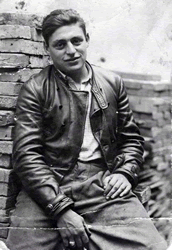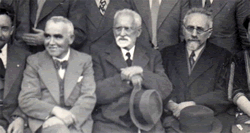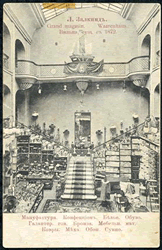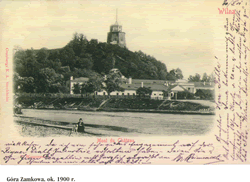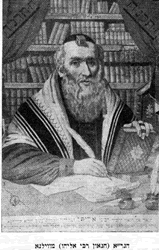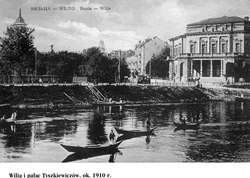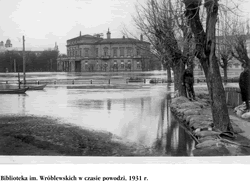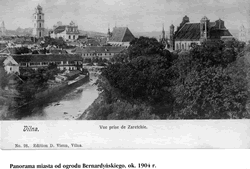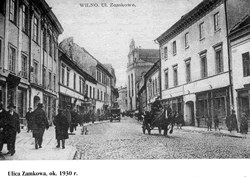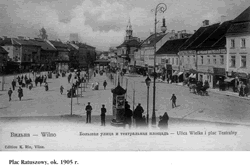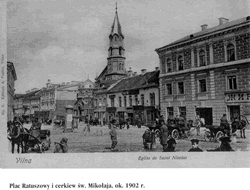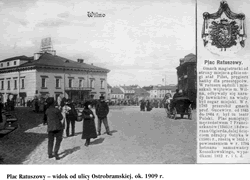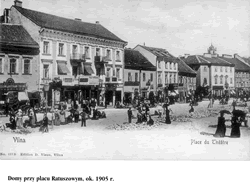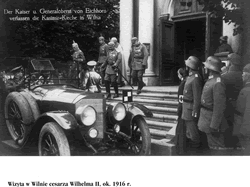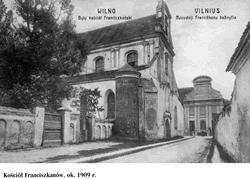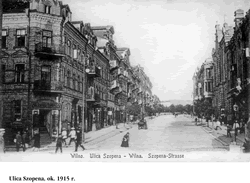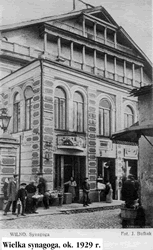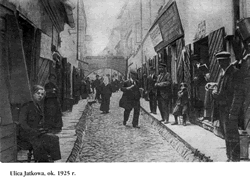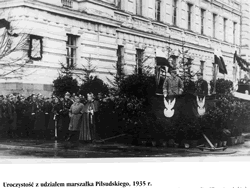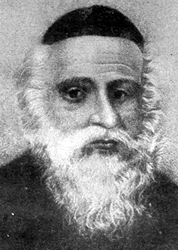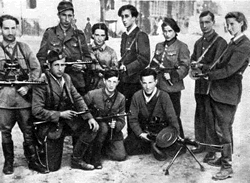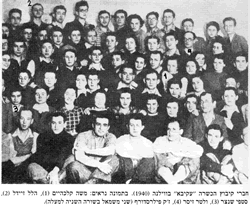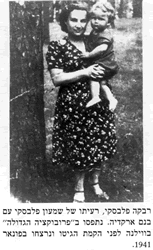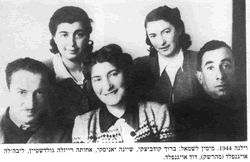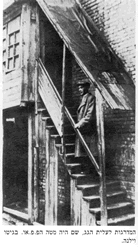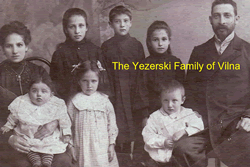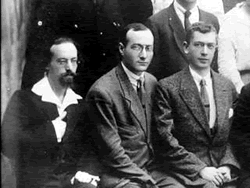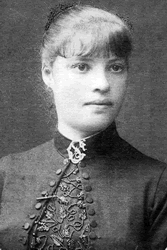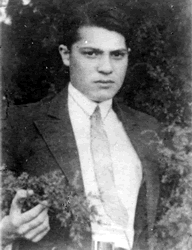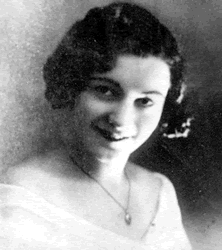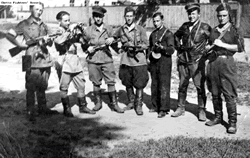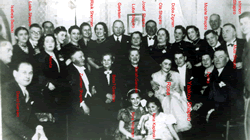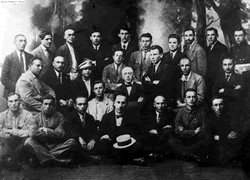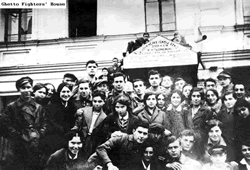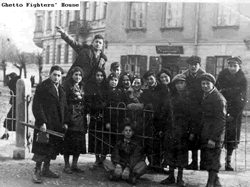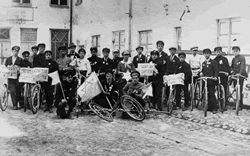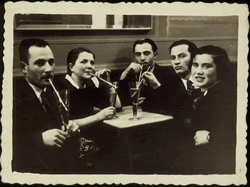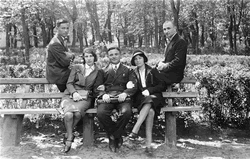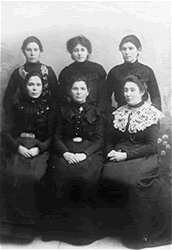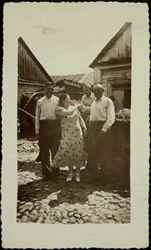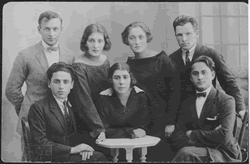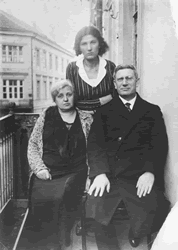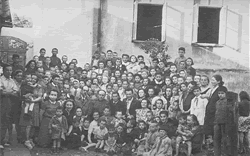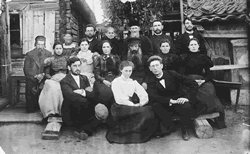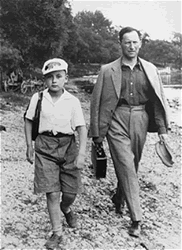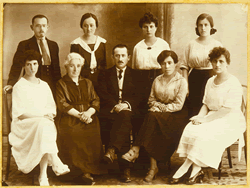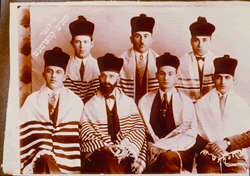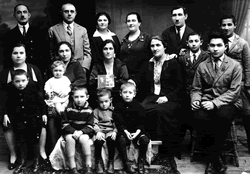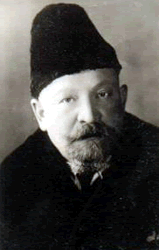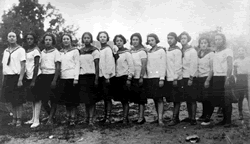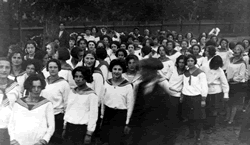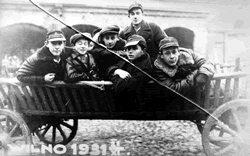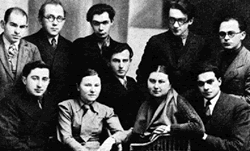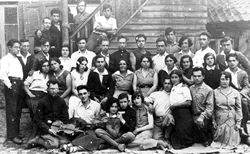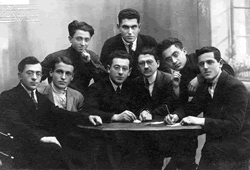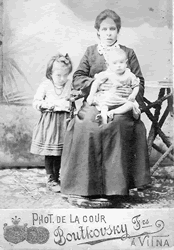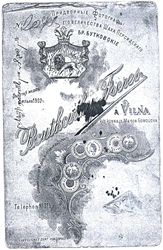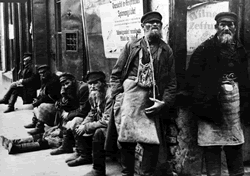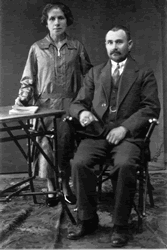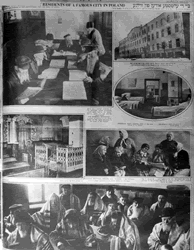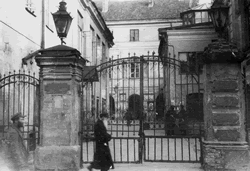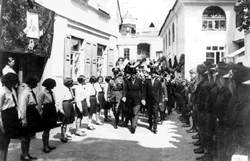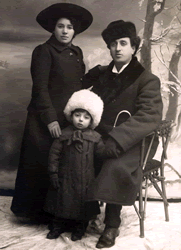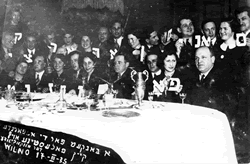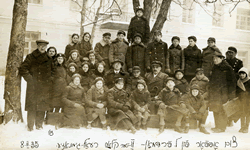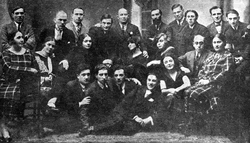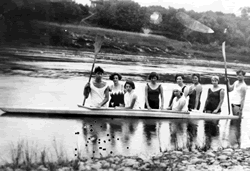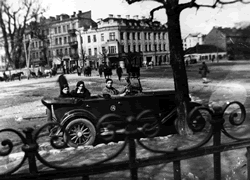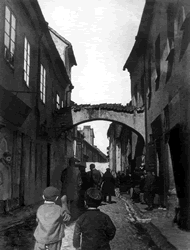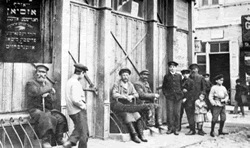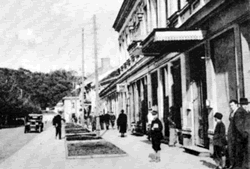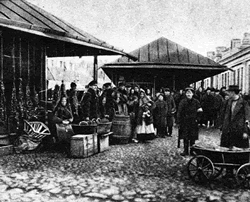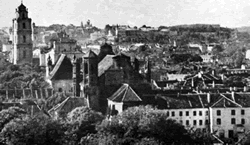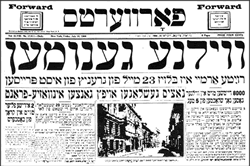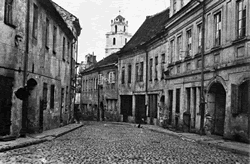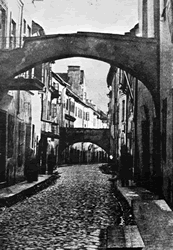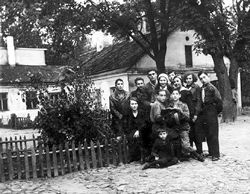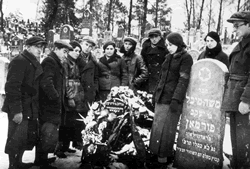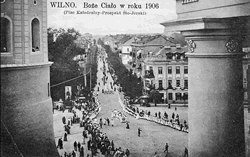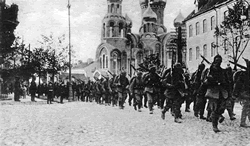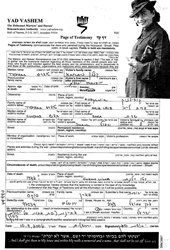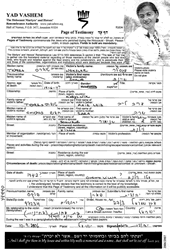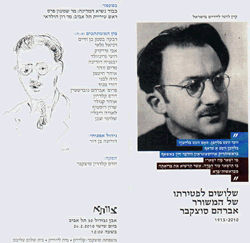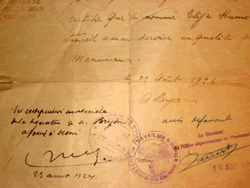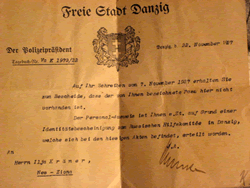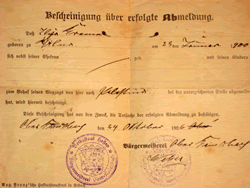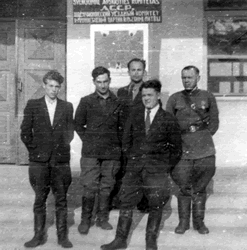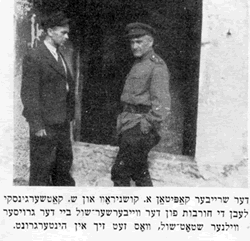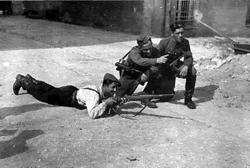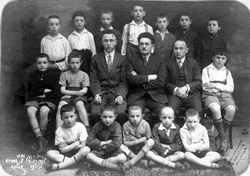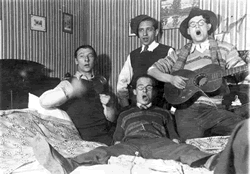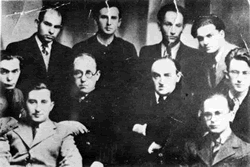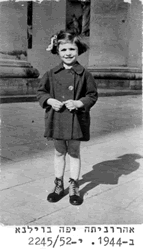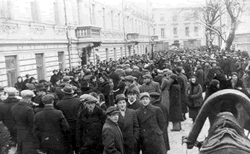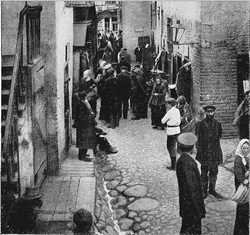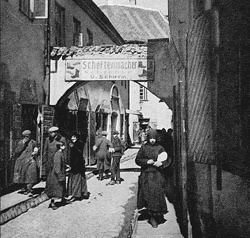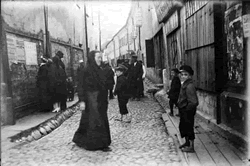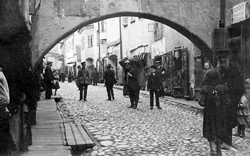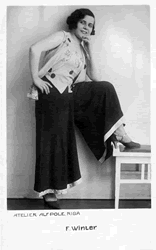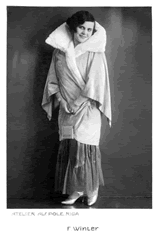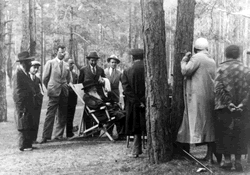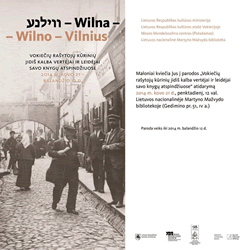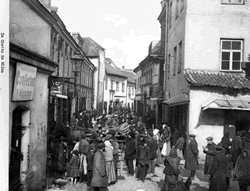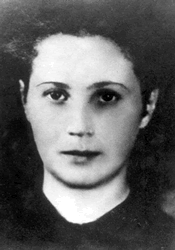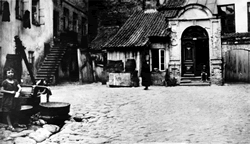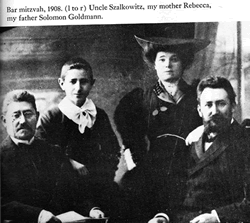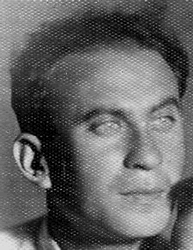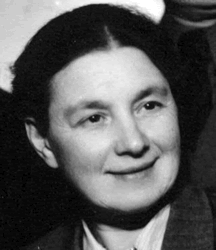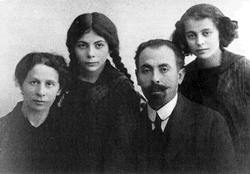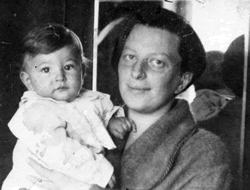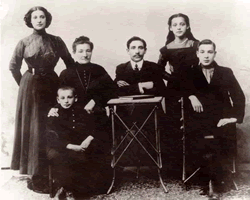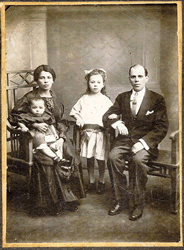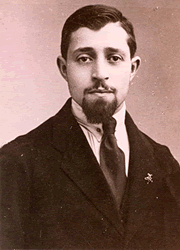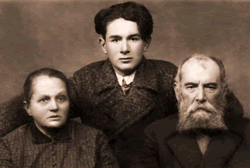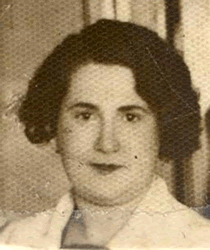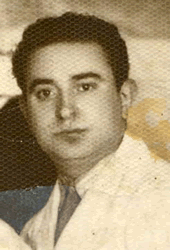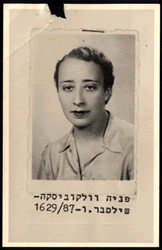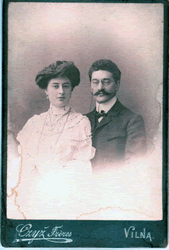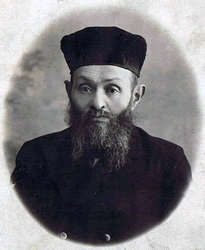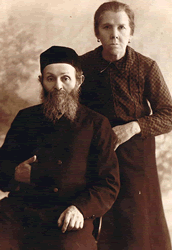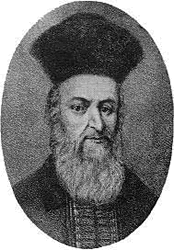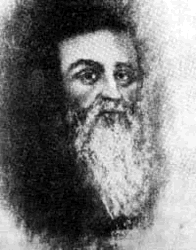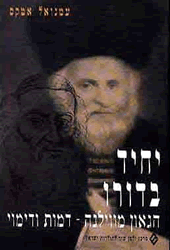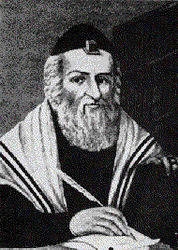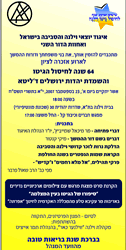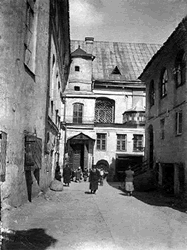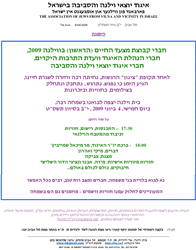"the Jerusalem of Lithuania" (East European Jewry) Vilne (Yiddish),
Wilno (Polish)
Today; Lithuania, 1944- 1990s; Soviet Union, 1921- 1939; Poland, pre First World War; Russian Empire.
From 1323 capital of the Grand Duchy of Lithuania
#vilna-1a: Jennifer Hayes wrote: My grandparents, Yankel and Zina Gurland, were from Vilna. My grandmother's maiden name was Serewitch. |
#vilna-1b: Scholars at an international scholarly conference at YIVO, Vilna (now Vilnius, Lith.), 1935: Elye Tsherikover (seated, fourth from right), Simon Dubnow (third from right), Raphael Mahler (standing, second from right), and others. (YIVO) |
#vilna-1c: Zalkind’s Department Store, Vilna. Russian/French/German postcard advertising a Jewish-owned department store established ca. 1872. (YIVO) |
#vilna-1d: |
#vilna-2: |
#vilna-3: |
|
#vilna-4:
|
#vilna-5:
|
#vilna-6:
|
|
#vilna-7:
|
#vilna-8:
|
#vilna-9:
|
|
#vilna-10:
|
#vilna-11:
|
#vilna-12:
|
|
#vilna-13:
|
#vilna-14:
|
#vilna-15:
|
|
#vilna-16:
|
#vilna-17:(1720-1797).
Rav Eliahou ben Shlomo Zalman (the Gaon from Vilna) |
#vilna-18:
|
|
#vilna-19: "Akiva" members, Vilna 1940 |
#vilna-20: Rivka Palavski ( first wife of Shimon) with son Arkadi. Rivka and Arkadi were killed in Ponar |
#vilna-21: Vilna, 1944; David Oyngfeld, wife, Leibale ( nee Maharshak), Reyzale Goldstein, her sister; Shena Yanivski and Baruch Kodvizki |
| #vilna-22: The Vilna Ghetto underground headquarters building |
#vilna-23: |
#vilna-24: Date; post World
War I , Vilna |
#vilna-25: Sarah Shapiro nee Gerstein, daughter of Leiba and Pnina perished in the Shoah in Ponary Pictures given by her great grandson; Gady Margalit in Israel |
||
#vilna-28: Jewish partisans from the "Ha - Noqem" (Hebrew: The Avenger) battalion in Vilnius (Vilna), after the liberation. Photographed in 1944. |
#vilna-29: The wedding of Rosa and Yaakov Shapiro ( They both perished in Vilna in 1944) Pictures given by their grandson; Gady Margalit in Israel |
#vilna-30: Delegates to a congress of the Tse'irei Zion movement, Vilnius 1921. Shlomo Farber (front row, second from the right); Menachem Rudnicki - Adir (front row, fourth from the right); Chaim - Shalom Kopilowicz (front row, third from the left); Avraham Solowiejczyk (front row, on the left); Lewin (standing, second from the right; first name unknown), a delegate from Molodechno; Israel Shafir (standing, third from the right); Nachum Kantorowic (standing, fourth from the right); Israel Marminski - Marom (standing, fifth from the right); and Margolis (standing, fourth from the left; first name unknown), a delegate from Svencionys. Also in the photo, seated: A. Katz, Shraga Antovil, Reuven Boniak, Shlomo - Yitzhak Alper, Eliahu Rodnicki, Nechama Horwic, Yitzhak Walk, Chaim Fejgin, and Yitzhak Schweiger, a Zionist emissary from Mandatory Palestine. |
#vilna-31: |
#vilna-32: |
#vilna-33: A bicycle trip for members of Zionist youth organizations in Vilnius (Vilna). The bicyclists, who set out on May 5, 1920 - the beginning of the Lag B'Omer holiday, carried a blue and white flag with the word "Zion" in Hebrew, and various placards, in Hebrew and Yiddish, with slogans in support of labor and the Jewish People's return to the Land of Israel. |
#vilna-34:Etchke Jurdyczanski (Isaac Juris), is second from right. He survived the Holocaust in Siberia, and the fate of the others is unknown. |
#vilna-35:Jewish students pose on a bench at the University of Vilna.Seated from left to right are: Rusia and her brother Abrasha Knyszynsky, Raya Markon and Max Heller (behind on the right |
#vilna-36:Pictured are Genya (Settel) Magid) and her five sister-in-laws. In the back row, from left to right are: Rachel Ass, Genya (Settel) Magid, Tzvia Rudashevsky, Esther Eppel, Rivka Garber and Fanya Mikalavefskaya |
#vilna-37:Vilna coachmen, Zelig and Yitzhak Shlankski, stand beside a loaded wagon in their backyard on the "Rabbi's Lane" (Dem Rov's Gessele"). |
#vilna-38:Students at the Hebrew gymnasium and teacher's seminary in Vilna.Dora Zlotnik standing second from left with friends and cousins from Eishyshok, Vasilishok and Olkenik. |
#vilna-39:Pictured are Genia and Boris Magid with their daughter, Katia. 1930 |
#vilna-40:Group portrait of students and teachers in a newly opened Jewish school in Vilna.Among those pictured is Cilia Jurer. 1945 |
#vilna-41:Pictured is Abram (Dov Ber) Magid (bottom row, right) with his sisters Tzivia, Rivka, Rachel and Esther, and other relatives 1910
Credit: USHMM, courtesy of Genya Markon |
#vilna-42:Pictured are Eli Rudashevsky and his son Yitzhak
courtesy of Cilia Jurer Rudashevsky USHMM |
#vilna-43:Group portrait of teachers and educators in Vilna. |
#vilna-44:Vilna Hazzanim (cantors) Gedalia Ginunski was a cantor in the Beth Midrash in Eisiskes as well as in the shtetl of Astrin. He also was a member of the Vilna Hazzanim (cantors) Quartet. Together with his wife and children, Gedalia was deported to Auschwitz, where he was forced to perform for the Germans. After an injury to his foot, he was sent to the gas chambers. His wife and children also perished |
#vilna-45: Berta/Batia Brudno and her son Simcha of Shavli, visit their Brudno relatives in Vilna c 1926. Top from right; Nechemia, Yehuda ( son of Avraham, grandson om Yehuda Leib Brudno), Berta ( oldest daughter of Avraham) , Sima/ Simcha ( youngest daughter of Avraham) David ( son of Avraham) Mr. Bladndes ( son in law of Avraham) middle; Moshe and Simcha (sons of Yehuda), Sarah ( wife of Yehuda) Berta ( holding picture of her husband, Aharon of Shavli (son of Avraham Brudno ) , Davids' wife, Sarah Blandes ( daughter of Avraham Brudno) Bottom; Leyzer Blandes, Simcha Brudno (son of Aharon and berta of Shavli) Yisrael and his brother (sons of David), Nechemia Blandes. All but Simcha Brudno ( son of Aharon) perished in the holocaust. |
#vilna-46: My grandfather, Reb Eli Chaiches/Chajches. He had a little stand in the Vilna market where he sewed and sold caps. He was also reputed to have been a Chazan and member of the choir in the great synagogue. Perished during the Holocaust. S.Joffe, Israel |
#vilna-47: Young sportswomen, members of the Maccabi sports union in Vilnius |
#vilna-48: Maccabi sports union in Vilnius (Vilna), on "Sports Day" in 1926. |
| #vilna-49: High school students from Vilna in 1931 |
#vilna-50: Yung-Vilne standing, left to right : Shmerke Katsherginsky, Avrom Sutzkever, Elkhonen Vogler, Khayim Grade, Leyzer Volf; siting: Moyshe Levin, Sheyne Efron, Shimshn Kahan, Rokhl Sutzkever, Bentsye Mikhtom |
#vilna-51: Members of the HeChaluts movement's pioneering training commune (kibbutz hachshara) in Vilnius |
#vilna-52: Members of the HeChaluts movement's Central Committee in Vilnius (Vilna). |
#vilna-53: Rochel (Skolnick) Weiner (Rachel in USA) |
#vilna-54: (reverse of #vilna-53) |
#vilna-55: Jewish porters, idle and waiting for work, standing beside the City |
#vilna-56: |
#vilna-57: A page of photographs in a Jewish illustrated magazine, showing |
#vilna-58: The entrance gate to the Shul Hoyf in Vilna |
#vilna-59: A visit by Polish President Ignacy Moscicki to the Great Synagogue in Vilna |
#vilna-60: A family photograph of L. Reif, his wife and their son |
#vilna-61: Members of the Maccabi sports union in Vilna at a dinner party |
#vilna-62: Second - year students in the Jewish gymnasiya for the sciences (Real) in Vilna, with their teachers, posing for a class photo 1935. |
#vilna-63 Members of the Jewish Drama Troupe on a visit to Vilna between the |
#vilna-64: A coed group of rowers, members of the Maccabi sports union in |
#vilna-65: Young Jews driving alongside a public square in Vilna in 1929. |
#vilna-66: Jewish children before the war |
#vilna-67: restaurant owned by Vulf (Velvel) Usian. The place was a favorite hangout for the Jewish actors and literary crowd it plays a major part in the stories of Abraham Karpinowitz. Vulf, his wife Zelda and their younger son Shaia, died in the Shoah, while his older son, Moshe, was in Israel. Moshe passed away in Israel in 1993, and his wife passed away in 2009. They had no children. Velfke was my Great-Grandfather's brother. My Great-grandfather (also Moshe) emigrated to the USA (via South Africa - a long story), and changed his name to Morris Usan. |
#vilna-68: |
#vilna-69: |
#vilna-70: |
#vilna-71: |
#vilna-72: |
#vilna-73: |
#vilna-74: Members of the HaNo'ar haTsiyyoni youth movement on the grounds of a community building in Vilnius (Vilna). |
#vilna-75: HeChaluts Members from the pioneering training commune in Vilna, at the graveside of their comrade Dov Dimenstein. |
#vilna-76: |
#vilna-77: The German army enters Vilna during the First World War |
#vilna-78: Yehudit nee Todres the wife of Shaul Kaplan perished in the Vilna ghetto. She was born to Arye Leib Todres and Sara nee Chodes |
| #vilna-79: Shane Weksler nee Todres was born in Kobylnik in 1916 to Arie and Sara nee Khadash. She was married to Schneur. Weksler. She perished in the Vilna ghetto |
#vilna-80: |
#vilna-81: |
#vilna-82: |
#vilna-83: |
#vilna-84: Jewish partisans |
#vilna-85: A notice of the local Commisar in Vilna, Taken from a newspaper |
#vilna-86: Jewish partisans from Vilna who fought in the Rudniki Forest returning to the city after its liberation.- |
#vilna-87: Vilna, Poland, 1928, A class at an elementary school. |
#vilna-88: Vilna, Poland, Shepsel (Shabtai) Blacher and other young men singing. |
#vilna-89: "Tzeirei Vilna" (Vilna Youth), in a literature club with Joseph Opatoshu, 1930. |
#vilna-90: Jaffe Aharonita Anita, 1944. She was born in Vilna in 1939 and survived in hiding. |
#vilna-91: |
#vilna-92: |
#vilna-93: |
#vilna-94: Luba and Yevgeniy Miranovich (Tuvia Finkelstein) with daughter, Vileyka, early 1950's |
#vilna-95: |
#vilna-96: Franya Winters a yiddish actress |
#vilna-97: Franya Winters a yiddish actress |
#vilna-98: EilaRabbi Gruzinsky with his students |
#vilna-99: |
#vilna-100: |
#vilna-101: Sonya Madesker, a resistance leader in Vilna. 1914- 1944 |
#vilna-102: View of part of the shulhoyf (synagogue courtyard), Vilna, ca. 1930s. (YIVO) |
#vilna-103: Nachum Goldman born in Vishnevo in 1894 at his bar Mitzvah in 1908 with his mother Rebecca nee Kwint or Baumgarten of Vilna. On the right is his father Solomon Goldman nee Liebman. On the left the brother of his father |
#vilna-104: Dovid Leib Labkovski, a painter from Vilna |
#vilna-105: Rivka Labkovski (nee Spektor/ Gurevitz) |
#vilna-106: Dina Abramowicz (1909-2000) with her family in Vilna. Her father, Hirsh Abramowicz, was an educator, Yiddish author, and member of the Jewish Labor Bund. He was visiting the US before the war and survived Her mother, Anna (Schreiber) Abramowicz, came from a prominent family. She perished. Her sister survived in France. Dina was a librarian at YIVO in Vilna before the war. She was a Yiddish language expert. Dina (2nd from left) Survived the holocaust. She later served as chief librarian at YIVO in NY |
#vilna-107: Ben-Tzion Bencion Bursztein the little baby of Antek Tzukerman.'s sister, Lena and her husband David Bursztein. He was murdered in Ponary along with his parents & grandparents. Antek tells that his friends form the underground made a special effort to save baby Ben Tzion but it was too late. |
#vilna-108: The Krovonik Family. Nechama and her children http://www.yadvashem.org/yv/en/exhibitions/vilna/background/index.asp |
#vilna-109: Notel Esterovich, his wife and children; Shalom and Rivka, in Vilna 1910. Notel and his wife perished in the Glubokie Ghetto. The family lived in Kaziany before and during the war . The children survived ( lived in Israel) |
#vilna-110: Yosef Meir Kovarski was born in in Vilna to Gdalyahu and Fruma in |
#vilna-111: My name is Andrey Guzhnovsky, I live in Moscow. My grandmother was the sister of Isser Ben Zvi. in 1915 ( First world war) her and her older brothers were evacuated to Orsha, they stayed in Russia. Isser with his parents were left in Vilna which became part of Poland. He was one of the leaders of Gordonia youth movement in Vilna. He immigrated to Eretz Israel in 1936. He was the chief operative in Poland 1945-46 of the Briha operation to help survivor escape from eastern Europe and arrive in Eretz Israel. Then he entered as one of the top political leaders of the Haganah 1947-48. Nahal created. etc. He was born in 1913 . Below I attached a picture of him with his parents father Hirsch ( Zvi), the mother of Mina. In the photo He is 15-16 years old. That is, it is the 1928-29 in Vilna. His name and his sister (Golutnaya) and their parents is the same as mine (Guzhnovsky).He became Ben-Zvi after repatriation. Named after Zvi Hirsch (his father) |
#vilna-112: Ester Cheikinski nee Vishnievski was born in Wilno, Poland. She was a hairdresser. Prior to WWII she lived in Wilno, Poland. Ester was murdered in the Shoah. |
#vilna-113: Berl Cheikinski was born in Wilno, Poland. He was a hairdresser. Prior to WWII he lived in Wilno, Poland. Berl was murdered in the Shoah. |
#vilna-114: Fania nee Kowarsky was born in Vidze To Chaia Sara and Yaakov. She was married to Dr. Noach Leon Wolkowski and lived in Vilna. They and had a son Alic ( later Alexander Tamir). Her husband perished in the holocaust. She and her son survived and immigrated to Israel. |
#vilna-115: Samuel and Rosa Goron |
#vilna-116: A photo of a younger Zelik Tarant, Erik McCall submitted the picture of his great great grandfather. |
#vilna-117: Zelik Tarant (born c1860) and his wife Hene,they lived in Vilna in the 1930s, but were actually from Vitebsk. |
Please share your comments or photos or links for posting on our Guestbook Page here: egl.comments@gmail.com
Vilna
also known as Vilnius (Lithuanian)
"the Jerusalem of Lithuania" (East European Jewry) Vilne (Yiddish
),
Wilno (Polish)
Today; Lithuania, 1944- 1990s; Soviet Union, 1921- 1939; Poland, pre
First World War; Russian Empire.
From 1323 capital of the Grand Duchy of Lithuania
ShtetLinks Page -- Vilna
http://www.shtetlinks.jewishgen.org/vilna/vilna.htm
The Virtual Jewish History Tour - Vilnius
http://www.us-israel.org/jsource/vjw/Vilnius.html
www.yad-vashem.org.il/exhibitions/ bogen/11.html
http://www.bh.org.il/Communities/Archive/vilna.asp
http://en.wikipedia.org/wiki/Vilna
The Vilnius Yiddish Institute
at Vilnius University;
http://www.judaicvilnius.com/en
YIDDISH LANGUAGE summer program;
http://www.judaicvilnius.com/en/main/summer/introduction
Originally published between 1901-1906 ;JewishEncyclopedia.com - WILNA:
Ancient Lithuanian city, capital of the district of the same name; situated
on the rivers Vilia and Vileika, about 200 miles southeast from Libau
on the Baltic, and 436 miles southwest from St. Petersburg. A Jewish
settlement existed there in the fourteenth century. The writer Narbutt,
in his history of Wilna, states that as early as the reign of the Lithuanian
chief Gedimin (1316-41) there was a large Jewish community in the place,
and that the space occupied by the streets inhabited by Jews was about
one-fifth of the area of the whole city. From fully reliable data accessible
to him, Narbutt even specified the names of the streets then inhabited
by Jews. The historian Bialinsky writes that under the reign of Olgerd
(1345-1377) the Jewish community of Wilna was considerable. This opinion
is expressed also by the writers Krashewsky, Kraushaar, Scherewsky (in
his book upon the Jewish records of the city of Wilna), and Vassilievsky.
The, last-named historian claims that at the end of the sixteenth century
the Jewish community of Wilna numbered from 10,000 to 15,000. Bershadski,
in his historical sketch (in "Voskhod," 1881) of the Jewish
community of Wilna, shows that the records preserved in the archives
evidence the existence of a Jewish community at Wilna since the second
half of the sixteenth century, but not before. He states authoritatively
that he was unable to find any trace in official sources of the existence
of a recognized Jewish congregation before that date. From scattered
indications extant in various Hebrew writings the conclusion may be
drawn that Bershadski's opinion, to the effect that a large Jewish community
represented by a rabbi is traceable only to the second half of the sixteenth
century, is nearer the truth than the others. In the responsa of R.
Solomon Luria of Lublin (second half of 16th cent.) there is found the
following:"We, the undersigned, hereby certify and witness with
our signatures that whereas we have been chosen as judges to decide
the controversy which has taken place at Wilna between R. Isaac b. Jacob
and R. Jonah b. Isaac, in the matter of the taxation of Polotzk. and
whereas the disputant parties appeared before us, and the aforesaid
R. Jonah has given to the aforesaid R. Isaac security in behalf of R.
Abraham b. Jacob and his brother R. Menahem. . . ."Signed at the
city of Wilna, on the first day of the week, the 7th of Shebat, in the
year 5316 [1556]:"Menahem b. Eliakim Triseash."Meshullam.
b. Jehiel."Meshullam. b. Judah."In none of the rabbinical
writings is mention made of these rabbis; but the litigants, R. Jonah
b. Isaac, R. Abraham b. Jacob and his brother Menahem (or Mendel), are
mentioned in the official records, and are cited by Bershadski ("Russko-Yevreiski
Arkhiv," No. 69) as the tax-farmers for certain localities, appointed
by the Polish king in 1556. In the responsa of Joel ha-Levi Sirkes ,
second collection (Koretz 1785), the closing paragraph of section 75
has the following: "The above is the testimony given before us
by Jacob b. R. Menahem Signed in the city of Wilna, on the fourth day
of the week, twenty-third day of Tammuz, in the year 5323 [1563]. Jonathan
b. R. Samuel, Eliezer b. R. Joel, Menahem b. R. Samuel Margolis."
In the exchange of correspondence on legal questions of Ma-HaRaM of
Lublin (Metz, 1769), the closing paragraph of section 7 reads: "By
this means the murderer was caught as set forth in full in the testimony
taken at the city of Wilna, on the third day of the week, on the twentieth
of Tammuz, in the year 5553 [1593]. " The fact, therefore, that
the Jewish community of Wilna was represented by several rabbis, and
not by one, as small communities are, is conclusive proof that the community
was at that time considerable.
Early Records. There is evidence also that Jews resided in Wilna in
still earlier periods. It is known that in 1490 the plenipotentiary
of the Grand Duke of Moscow, in a letter to King Casimir, complained
of the excessive tax imposed upon merchants traveling to and from Moscow
through Wilna by the Jewish lessee of taxes Michael Danilow ("Regesty
i Nadpisi," i., No. 208, St. Petersburg, 1899). In 1495 the grand
duke presented to the city of Wilna some property which formerly had
been owned by a Jew named Janischevsky (ib. No. 215). In 1507 King Sigismund
wrote that he had bought various goods from the Jewish merchant Michael
Rebinkowitz (Yesofovich; ib. No. 231). Under the date of 1508 there
are statements of accounts of Jewish lessees of taxes in Wilna and Brest-Litovsk
(ib. No. 234). In 1532 the Jew Joshua Paskowitz was appointed by King
Sigismund as chief collector of taxes on wax in the market of Wilna
(Bershadski, "Russko-Yevreiski Arkhiv," No. 140). In 1550
a certain Jewess, Fanna Kasparova, who resided at Wilna, refused to
surrender to the Jewish court the Jew Chatzka Issakowitz, defying the
Jewish court messenger sent to take him, although she had previously
given bond for the appearance of the said Issakowitz (ib. No. 167).
In 1555 King Sigismund granted to a certain Jew of Wilna a lease for
three years of the privilege of stamping coins (ib. No. 45). The lessees,
in 1560, of the privilege of stamping coins in Wilna were the Jews Felix
and Borodavka (ib. No. 125). In Sept., 1562, a Gentile brought before
a magistrate a charge of assault against a Jew by the name of Israel,
the defendant being described in the complaint as a physician (ib. No.
167). In 1568 King Sigismund issued an order commanding the Jewish community
of Wilna to pay the taxes due to the treasury ("Regesty i Nadpisi,"
No. 557). In 1583 the Jew Judah Salamonowitz of Wilna paid taxes on
goods brought by him from Lublin to Wilna, consisting of a truckload
of wine, licorice, and linen ("Archeographicheski Sbornik,"
part iii., p. 289). The name of the Jew Moses Tomchamowitz of Wilna,
secretary of the mint, is mentioned in the records of 1587 ("Regesty
i Nadpisi," No. 660). In 1592 the citizens of Wilna attacked and
destroyed the bet ha-midrash of Wilna ("Records of the Community
of Wilna," part xxviii., p. 52, Wilna, 1901). In 1593 King Sigismund
III. granted to the Jews of Wilna the privilege of buying real estate
from the noblemen of that city; at the same time he made many other
concessions to them, including permission to rebuild the bet ha-midrash
(Bershadski, in "Voskhod," 1887). From the above data it is
evident that there was a large Jewish community in Wilna in the middle
of the sixteenth century, but that until then it was insignificant.
The Jews' street in Wilna, the one formerly called by the name of St.
Nicholas, which terminates at the Hospital of St. Mary, was known as
the "Jews' street" in 1592 (Bershadski, "Istoria Yevreiskoi
Obshchiny v Wilnye," in "Voskhod," 1887, p. 84), and
is still so called.
In the Seventeenth Century.
In the seventeenth century the Jews in Wilna and in Lithuania generally
enjoyed peace and prosperity. At the beginning of their settlement in
that country their relations with the non-Jewish population were very
friendly. Even from the orders given by Bogdan Chmielnicki to the Polish
and Lithuanian magnates it is evident that up to that time the Lithuanian
Jews lived in happiness and peace, and that only the Cossacks subjected
them to oppression and maltreatment. But from that time on they gradually
sank into misfortune. The conclusion to be drawn, therefore, from the
study of the history of the Jews of Wilna during that period is that
the kings and rulers of Poland and Lithuania were considerate toward
them, but that the non-Jewish population was extremely hostile. In 1636
King Ladislaus IV. granted certain important concessions to the Jews
of Wilna. In 1669 King Michael confirmed six privileges previously enjoyed
by them. King John III., in 1682, permitted them to conduct their own
census-taking. Five years later (1687) the same king wrote to the commander
of his army and to the governor of Wilna warning them to see that the
Jews of Wilna were not molested by the non-Jewish population, and telling
them that they would be held personally responsible and punished severely
for any violation of this order.
(see image) Interior of the Old Synagogue at Wilna.(From a photograph.)
From the seventeenth century on the Wilna Jews passed from tragedy to
tragedy, the differences being only in degree and extent, as may be
seen from the series of restrictions and limitations imposed upon them,
leading at times to riots and consequent destruction of property. In
1635 the populace, in a mood of frenzy, destroyed the newly erected
and elaborately appointed Jewish prayer-house at Wilna, tearing to pieces
eighteen scrolls of the Law, appropriating their golden handles and
everything else of value, and not leaving a stone of the prayer-house
unturned (Bershadski, in "Voskhod," May, 1887). In 1653 King
John Casimir was induced to issue a circular prohibiting the Jews from
engaging in certain businesses and from accepting employment as servants
in the houses of Gentiles ("Regesty i Nadpisi," No. 940).
In 1663 the trade-union of Wilna passed an ordinance prohibiting Jewish
glaziers from entering that union, and forbidding glaziers to receive
Jewish apprentices or to employ Jews in any other capacity (ib. No.
1019). In 1664 the fishermen's union of Wilna excluded the Jews from
the fishing trade (ib.). In the same year the king yielded to the request
of the citizens of Wilna and prohibited the Jews from engaging in the
occupations of silversmiths and goldsmiths (ib. No. 1022). It seems
also that two years later (1666) the Jews were excluded from the grain
business (ib. No. 1041), in 1667 from tanning (ib. No. 1056), and in
1669 from the bristle manufacturing business (ib. No. 1078). But as
long as Wilna remained under Polish and Lithuanian rulers all those
restrictions and limitations were tolerable; the real and acute suffering
began with the conquest of Wilna by the Russians in 1654, when the savage
hordes of Cossacks, led by their barbaric chieftain Chmielnicki, destroyed
everything destructible in the city, and killed every Jew they met (see
"Entziklopedicheski Slovar," vol. vi., p. 384). The Jews that
remained were banished from Wilna by order of the Russian king Alexis
Mikhailovich ("Regesty," No. 971).
Calamity of 1655.
To this wholesale expulsion from Wilna reference is made in the preface
of "Be'er ha-Golah" by R. Moses Ribkes: "And on the fourth
day of the week, on the 23d of Tammuz, in 5415 [1655], the whole congregation
fled for its life from the city of Wilna, as one man. Those who had
provided themselves with conveyances carried their wives, children,
and their small belongings in them; but those who had no conveyances
traveled on foot and carried their children on their backs." Further
reference to that catastrophe is made in the "Bet Hillel"
on Yoreh De'ah (section 21), and in the responsa collection "?ema?
?ede?" (No. 101). Among the exiles from Wilna in that year were
the following prominent rabbis: Aaron Samuel b. Israel Kaidanover (who
afterward became rabbi of Cracow, and who used to supplement his signature
with the words, "the exile from the city of Wilna"; see the
preface to his "Birkat ha-Zebach"); Shabbethai b. Meïr
ha-Kohen (author of "Megillah 'Afah," in which the Wilna catastrophe
of that year is described); and Ephraim b. Aaron (author of "Sha'ar
Efrayim"). Wilna remained in the hands of the Russians for about
six years, when it again came under the rule of the kings of Poland;
the lot of the Jews, however, remained as bad as ever.The vernacular
of the Jews of Wilna at that time seems to have been Russian. This conclusion
is drawn from the following statement in the volume of responsa "Geburot
Anashim" (p. 26): "It happened in the city of Wilna that a
man, at the wedding ceremonies, used the Russian language in betrothing
his bride, 'Ya tebja estum me?addesh.'" The date following this
is Dec. 26, 1636.
(see image) Part of the Old Cemetery at Wilna. Star Shows Tombstone
of Elijah Gaon.(From a photograph.)
The Eighteenth Century.
(see image) Page from Shulchan 'Aruk, Printed at Wilna, 1880.Nothing
important of a favorable nature happened to the Jewish community of
Wilna during the eighteenth century. In 1708, when Wilna was taken by
Charles XII. of Sweden, more than 20,000 died there from famine and
pestilence in a comparatively short time; a great number of Jews being
among these, the community became poverty-stricken, and many were compelled
to leave the city ("Entziklopedicheski Slovar"). The author
of the "Rosh Yosef," in his memoirs (Preface), says: "The
wrath of the oppressor compelled me to leave my place of residence,
for his arm was stronger than ours, and the wo and terror which entered
our locality deprived us of our resting-place in the country of Poland."
The Jews now fell into such depths of poverty that they were unable
to save their principal prayer-house from being sealed by creditors.
In the "pin?es" of the ?eda?ah Gedolah (the principal charitable
society), under date of the 2d of Elul, 5466 (Aug. 30, 1707), the following
entry oc curs: "In those days the synagogue was closed and sealed
for almost a whole year. The cemetery also was closed." On the
return to the throne of King August of Saxony in the year 1720, the
populace of Wilna, mindful of its hatred toward the Jews, requested
him to reduce the privileges heretofore granted to the latter in connection
with the grain business. The king did not yield to the request at that
time; but in 1742 the citizens secured the support of the magistrate,
who compelled the representatives of the Jewish community to sign and
execute an agreement in which they surrendered their former rights and
privileges. Thus the Jewish community of Wilna continued to dwindle
down to the time of the permanent occupation of Wilna by the Russians,
when the position of the Jews improved somewhat—when,
in fact, they lived under conditions much more favorable than those
of the present day.Rabbis.Following is a list of the more important
known rabbis of Wilna: Abraham Segal (first rabbi of Wilna; mentioned
by the author of "Sefer Toledot Yi??a?," Prague, 1623); Menahem
Manus ?ajes (mentioned in "Etan ha-Ezra?i," Koretz, 1636);
Feibush Ashkenazi (mentioned in the "'Abodat ha-Gershuni,"
No. 67, and in other works); Moses b. Isaac Judah Lima (author of "?el?at
Me?o?e?"); Isaac b. Abraham of Posen; Na?man b. Solomon Naphtali
of Vladimir; Moses b. David (known also as R. Moses Kremer); R. Simson
(in his old age settled in Palestine); Hillel b. Jonah ha-Levi; Baruch
Kahana Rapoport; Joshua Heshel; Samuel (the last head of the bet din).
From R. Samuel's time the title "rosh bet din" was discarded,
no rabbi subsequently elected being authorized to assume that title;
since then the rabbi has been called "moreh ?ede?." The reason
for the abolition of the title was a quarrel in which R. Samuel was
involved as a result of his having treated the community with disrespect.
The rabbinic school or yeshibah, founded in 1847, but closed in 1873,
was one of the most prominent in eastern Europe. Wilna is distinguished
not only by its rabbis but also by the large number of eminent Hebrew
scholars who have been born or have resided there. Among these may be
mentioned: Judah Löb Gordon, Lebensohn, Reichenson, etc.In
1875 the Jews of Wilna numbered 37,909 in a total population of 82,688.
The census of 1902 showed about 80,000 Jews in a total population of
162,633. The explanation of this rapid increase, which is out of all
proportion to the ordinary growth of urban populations, lies in the
"May laws" of 1882, which prohibited Jews from living in rural
districts, and thus brought a large number to Wilna, as to other cities.
In Hebrew literature Wilna is described as the "mother city in
Israel," or the "Lithuanian Jerusalem": the latter term
originated, probably, with Napoleon I., when he was in Wilna in 1812.Communal
Institutions.Wilna contains a teachers' institute (Jewish), the only
one of the kind in the whole of Russia. To it four subordinate elementary
schools for Jewish children are attached. After graduating from the
higher school the students receive diplomas as teachers; the number
of such graduates is about twelve or thirteen annually. The money for
the support of the institute, about 30,000 rubles per annum, is appropriated
by the government from the municipal meat-tax of Wilna, the burden of
which falls mainly upon the poor class of the Jewish population, since
members of the liberal professions and college graduates are exempt
from that tax, and the well-to-do class, not being strictly Orthodox
as a rule, are more or less indifferent to the use of kasher meat. There
are about twenty elementary schools for Jewish children, called "people's
schools." But neither in these schools nor in the teachers' institute
and its subordinate schools is instruction given in even one specifically
Jewish subject.A soup-kitchen for Jews is maintained in Wilna, in which
a substantial meal, consisting of bread, soup, and meat, can be had
for 4 copecks (2 cents). The kitchen is much used by Jewish soldiers
stationed in the city; the extremely poor receive their meals free.
It is supported by voluntary subscriptions, exclusively from Jews, and
by the proceeds from certain Jewish balls and lectures. About 30,000
persons annually receive meals from it, one-half being non-Jews. About
112 soldiers are annually recruited, under the general conscription
laws, from the Jewish community of Wilna. The Jews are mostly engaged
in the export of lumber and grain, and in shopkeeping. Poverty, prevalent
throughout Russian Jewry, is especially marked in Wilna. It may safely
be maintained, although no actual statistics are available, that fully
80 per cent of the Jewish population of Wilna do not know in the evening
where they will obtain food the next morning. In former days a considerable
number of people made their living by the liquor trade, keeping saloons
and inns; but a few years ago the Jews were excluded from that trade
by governmental ordinances. Recently model tenement-houses have been
erected for the Jewish workmen of Wilna by the Jewish Colonization Association.The
district of Wilna contains 1,706,357 inhabitants, of whom 245,771 are
Jews. Of the latter 3,921 are occupied in agriculture.
Bibliography: Regesty i Nadpisi, St. Petersburg, 1899;
Bershadski, Russko-Yevreiski Arkhiv;
idem, Ocherk Wilenskoi Yevreiskoi Obshchiny;
Voskhod, 1881-87;
Akty Wilenskoi Kommissi, 1901-2.H. R. B. R.
”Typography: A Hebrew printing-press was established in Wilna in 1799 by Baruch Romm, as a branch of his establishment at Grodno. Through the action of the Russian censorship this press had practically a monopoly of the Russian and Polish markets from 1845 onward, when the printing of Hebrew books was restricted to Wilna and Slavuta. Between 1847 and 1857 the Wilna press produced no less than 460 different works (enumerated by Benjacob in Steinschneider, "Hebr. Bibl." iv-v.). Thisyearly average of 41 works was raised to 63 in 1871 (E. Reclus, "Nouvelle Geographie," p. 436). Especially noteworthy were the Talmuds of 1835 and 1880, which have proved the standard editions for the east of Europe: a specimen page of the latter is given in illustration of the article Talmud. Besides the many books printed by the Romms, the periodical "Ha-Karmel" is published at Wilna.J.
Vilna
(VILENSIS).
Vilna, the capital of Lithuania, is situated at the junction of the
Rivers Vileika and Vilja; population 165,000 in 1910. Its foundation
is traced back to the twelfth, and even, by Polish writers, to the tenth
century; but its historical origins must be referred to the year 1323,
when Giedymin, Grand Prince of Lithuania, set up his capital there,
wrote a letter to John XXII, and made treaty with the Brethren of the
Sword. The German Crusaders partly devastated the city in 1383. When
the grand Prince Jagiello, in 1383, received baptism and married Hedwige,
Queen of Poland, taking the name of Wladislaus II, and uniting Poland
with Lithuania, the religious and political prosperity of Vilna began.
In 1577 it became the seat of a flourishing academy which gained a great
literary reputation, especially under the Jesuits. In the later half
of the seventeenth century and the earlier of the eighteenth it suffered
much from war, fire, and pestilence. United with Russia in 1794, it
ceased to be the capital of the Grand Duchy of Lithuania. The Polish
insurrection of 1831 and 1863 exposed it to cruel reprisals; from 1870
it has developed industrially and commercially.
From The Catholic Encyclopedia, Volume XV
Copyright © 1912 by Robert Appleton Company
ELIJAH WILNA, or ELIJAH BEN SOLOMON, best known as the GAON ELIJAH or
WILNA (1720-1797), a noted Talmudist who hovered between the new and
the old schools of thought. Orthodox in practice and feeling, his critical
treatment of the rabbinic literature prepared the way for the scientific
investiga-tions of the ipth century. As a teacher he was one of the
first to discriminate between the various strata in rabbinic records;
to him was due the revival of interest in the older Midrash (q.v.) and
in the Palestinian Talmud (q.v.), interest in which had been weak for
some centuries before his time. He was an ascetic, and was a keen opponent
of the emotional mysticism which was known as the new Hassidism
the Jewish EncyclopediaImages for: Â WILNA:
By : Herman Rosenthal  Baer Ratner  Joseph
Jacobs Â
Caption:Â Part of the Old Cemetery at Wilna. Star Shows Tombstone
of Elijah Gaon.
Source:Â (From a photograph.)
By Steven Lasky . Steve wrote; "...in "How Our Ancestors Came to America: From Vilnius to Ellis Island," I have listed on at least sixteen pages, all of the names, years of immigration and birth of all those listed as last residing in Vilnius before their emigration, i.e. from about 1892 through 1924. The entire list contains nearly 20,000
names (I have included everyone, Jews and non-Jews alike)!..."
http://www.museumoffamilyhistory.com/lee-ftp-vilnius-a-ba.htm
Once it became known that exit permits were available, efforts were made to obtain the necessary documentation by many who had previously refrained from doing so. Thus, visas to Curacao were obtained from A. M. de Jong, the Dutch consul in Stockholm, and Nicolaas Aire Johannes de Voogd, the Dutch consul in Kobe, Japan. Japanese transit visas were procured from consuls in various Russian cities, primarily with the help of the Japanese N.Y.K. (Nippon Yusen Kaisya) shipping line, which provided visas to those for whom boat tickets had been purchased. Several hundred refugees who possessed visas to the United States, Palestine, and other countries traveled via Japan, leaving the Soviet Union by means of the Curacao and/or Japanese visas; among them were such prominent rabbis as Aron Kotler, Reuven Grazowsky, and Moshe Shatzkes.
Transfer
to Shanghai
Beginning in the early spring of 1941, the Japanese attempted to halt
the entry of Jewish refugees to Japan, but despite their efforts, more
than 500 Jews entered between April and August. That summer, the Japanese
sent those Jewish refugees who were unable to emigrate to Shanghai, where
most remained for the duration of the war. During the period from October
1940 to August 1941, a total of 3,489 Jewish refugees entered Japan. Of
these, 2,178 were of Polish origin, among them more than 500 rabbis and
yeshiva students. In the spring of 1941, efforts were made to arrange
for the entry of refugees from the Soviet Union directly to Shanghai,
and the necessary permits were obtained. It is not known how many of these
documents were actually utilized (apparently between 50 and 150). Courtesy
of:
"Encyclopedia of the Holocaust"
©1990 Macmillan Publishing Company
New York, NY 10022
Slownik Geograficzny Entry
Wilno (now Vilnius, Lithuania
PolishRoots® Geography
In Latin - Vilna, in Lithuanian - Wilniuja, in White Russian –
Wilnia. A mediaeval stronghold, once the capital the Grand Duchy of Lithuania,
today the county and guberniya town and headquarters of higher administration
offices and the army. It lies 50° 41’ latitude
north, 42° 57’ longitude east and 118.2 m
above sea level. It stands at the point the river Wilejka enters the river
Wilia, in a valley surrounded by hills from whence a beautiful panorama
extends. Distances by rail in verst to the following cities: St. Petersburg
– 658, Moscow – 875, Warsaw –
387, Kiev – 862, Minsk – 173, Wierzbolowo
– 177, Kowno – 97, Grodno –
147 and Ryga – 365.Location and climate In geognostic
terms, the town lies on a plain, tilting from the Pinsk Lowlands towards
the Baltic Sea. To the east and west, the elevated upper layers of land,
on which the town stands, are of sand. The alluvial hills surrounding
the Wilia river bed are only of sand but those around the Wilenka occasionally
contain clay. There are two springs in the town, one by the Zamkowa hill
containing traces of hydrogen and sulphur, the other, more iron flavoured,
on the Rowne Pole. Their presence points to the possibility of the existence
of more. In his geognostic description of Wilno, (Opyt medico-topograficzeskiego
opisania goroda Wilny pages 9 – 27), Salkind describes
this subject in great detail. Here we must add that the land in the lower
part of the town, the complete area in the vicinity of the castle, from
the banks of the Wilenka and Wilia to the hills on which the buildings
of the Catholic seminary, the post Dominican and post university stand,
are boggy and full of springs and meadows. Water in Wilno is plentiful
and never far beneath the surface.The soil in the town and environs is
primarily sand and these layers often attain a depth of several ells (Nordischer
Sand); then follows a layer of ordinary red clay “oven
clay� which is unsuitable for brick making due to the high
content of lime stones (top red alluvial clay, top red marl); beneath
a layer of alloy-yellow coloured clay, which is a type of marl and containing
veins of excellent pottery clay (marga argilacea, argilla plastica) and
finally the deepest lying, thin layer of gravel or large–grained
sandy limestone. In the hills surrounding the town there are innumerable
primary rock fragments, the most popular being granite, gneiss and grinstein
and these are used to pave the Wilno streets. Homogeneous minerals have
been found beneath the town and include cinnamic stone, hornstone, in
the shape of rounded stones, (Hornstein; according to Gedrojec this is
not hornstone as maintained by Jakowicki but silex or Feuerstein) and
fossilised wood. The bones of a mammoth, an elephant’s
molar tooth and various other, less significant, fossils have been found
on the banks of the Wilia and on the flat country beyond. A description
of the latter can be found in an article by Jakowicki in the Wilno Daily
1830, III, 80).Wilno also has its own specific flora, details of which
can be found in Balinski’s Statistical Description of
Wilno, 9, 23. Balinski collected what he found by Gilibert and Jundzillow;
the latter did much for the country’s flora but omitted
many species known only in Wilno. Presently, Ms. Tekla Symonowicz, known
for her work in the field of botany and for her rich herbarium, is preparing
to take to print a detailed account of Wilno’s flora.The
climate, although changeable, is temperate and healthy. The real spring
warmth begins here with the onset of April and sometimes even in March;
however when the polar ice begins to melt, the northern winds bring cool
weather and frosts with them and snow has been known to fall as late as
May. The hottest days are experienced in July but October can be almost
just as warm. Summer temperatures can reach +26.2° but they
normally range from +22° to +24°. The coldest temperature
registered was -29.5°. The average annual temperature is +6.80°
(Wild’s temperatures in the Russian Empire); average
winter temp. -4.56°, spring +6.80°, summer +17.94°
and autumn +7.20°. The greatest annual temperature fluctuation
occurs in January and July, a slight one in February and August and the
smallest in April and November. The highest temperature +33°
was recorded in July and the lowest -38.8° in January. The
highest atmospheric pressure of 752.6mm was noted in January and 751.8
in February; the lowest 748.6 in July and 748.9 in December. The south
wind prevails, followed by the west wind and the most uncommon are the
north and north-east ones. The declination of the magnetic needle observed
by implementing a simple theodolite was 13. The longest day in Wilno lasts
17 hours.Expanse, parts of the town and policing areas Wilno covers an
expanse of 8 square wiorst and its boundary is 27 wiorst and 75 saz. The
straight line from Ostrabrama Street to Antokol suburbs measures 7 wiorst;
from Pohulanska to Polocka suburbs, 2w. 350 saz. Wilno has spread throughout
the valley surrounded by hills of varying sizes.The city is, in fact,
divided into the actual city and suburbs encompassing it from all sides.
Travelling from north to west we first encounter Antokol, which resembles
a town rather than a suburb considering its population. It nears the city
with each year as the number of houses increases and will soon be swallowed
by it. Those “ manors in Antokol,� so poetically
described by Chodzko, no longer exist. They have been replaced by multi
storey buildings and factories. A thick pine forest, belonging to the
Greek Orthodox nuns, separates Antokol from Popowszczyzna, which lies
to the north east and used to be a suburb but today is integrated into
the city. This part of the city is named Zarzecze. Poplawy suburbs, now
adjoining Zarzecze, lie more to the east but are separated from it by
the river Wilejka. Towards the south and south west there are the suburbs
of Nowy Swiat, Szkaplerna and Kominy which make up a unit and are quickly
approaching the city. Nowy Gorod and Hulanki are to the south and south
west. The former is a town in itself, even a fair-sized one, taking the
number of houses into account. 15 to 20 years ago, Pohulanka was the summer
escape of the privileged and a popular excursion goal. Today, it is a
beautiful part of the city. Lukiszki lie to the west and Snipiszki to
the north west. Lukiszki is in a valley whereas Snipiszki lies higher.
Antokol and Popowszczyzna are separated from the city by the river Wilejka
and Snipiszki by the Wilia. Other suburbs and the city itself are on the
left bank of the Wilia. On the edge of the suburbs we find the summer
houses or “dachas.� They are usually situated
in such picturesque places as Werki, Zwierzyniec, Zakret, Rybiszki, Markucie,
Betleem, Belmont, Wilanowo, Rossa etc. The city has expanded in a most
uneven and hilly area so that not only is one street higher or lower than
the next but even the street itself can in one part be steeply elevated
in relation to another. The town consists of 8 suburbs, 13 squares, 65
streets and 39 alleys. From a policing angle it is divided up into 7 circles
of which VII is Antokol, VI includes Zarzecze and Popowszczyzna, V Rossa
and Poplawy, IV Snipiszki and I Szkaplerna. Nowy Swiat and part of Nowy
Grod do not belong to the county.Most of Wilno’s streets
are twisting and winding. There are barely 3 straight streets commonly
known as “Prospect.� They are relatively
new and bare the names St. Jerski, Aleksandrowski and Aleksandrowski Boulevard.Population
Regarding population, Wilno ranks 111 in Europe and 12 in Russia (Bracchelli:
Statistik der Europaeschen Staaten). Due to a lack of documentation, it
is difficult to say how the population grew. Some historians maintain
that Wilno had around 30.000 inhabitants in the XIV century, gradually
reaching the figure of 120.000 in its heyday, during the reign of Zygmunt
August. The city lost its splendour during following reigns and Jan Kazimierz’s
reign (1655) saw 25.000 citizens die and even more scatter. In 1766, Karpinski
mentions a population of 60.000 (Geographical Lexicon). In 1830, Chodzko,
records 50.000 of which 30.000 were Jews. In 1835, Balinski mentions 35.922
(Statistics of the city of Wilno). That figure is incorrect because the
VIII census in 1834 census mentions 52.269 citizens and according to official
documents 1836 there were 30.253 males, 25.882 females, together 56.135.
According to official documents in 1846 there were 27.871 males, 26.311
females, together 54.182 inhabitants. In 1850, the IX census gives 49.006,
the X census in 1858 mentions 58.175 and finally the 1875 census notes
42.178 males, 40.490 females, together 82.668. From that one-day count
in 1875 there has not been another registration and so we have to make-do
with those “memorable books� published
annually by the guberniya statistics office. The information included
is fairly accurate as the figures are obtained as follows: births/deaths
of the current year are added/subtracted to/from the figures of the past
year. The office receives these figures from the police and consistories.
According to these books the population in 1886 was 107.286 and in 1890
there were 53.039 males, 56.769 females, together 109.808 of which 13.787
Orthodox, 746 Rozkolnik, 33.628 Catholic, 1.820 Lutheran, 142 Calvinist,
63.698 Jew, 127 Karaite and 360 Mohammedan.During the period 1875 and
1888, the number of births registered was 36.385. Of these 24.776 were
Christian and 11.500 Jew and the ratio was 100 girls to 133.3 boys. 27.6
children were born to every 2.000 adults. During the same time frame there
were 39.046 deaths of which 21.637 were male and 17.409 female. As far
as the birth rate is concerned we note it is small and we shall examine
it closely by religion. The former has a birth rate ratio of 4:1 and,
as to the latter, it is impossible to give even a near accurate account
as the figures provided for both deaths and births are compiled very haphazardly.
During the 14 year period the Jewish population increased by 13.079 heads.
When compiling the figures we attain a decrease of 401:6 and for the 14
year period it shows a decrease of 5.622. This does not coincide with
the known fact that mortality among the Jewish population is negligible.According
to the Duma statistics, Wilno has 1.509 brick-built houses, 1.169 wooden,
together 2.678. The ones in the city are all brick-built but for a few,
25-30 wooden ones. On the outskirts and in the poorer parts of the city
the houses are mainly wooden e.g. Nowy Gorod, Popowszczyzna, Szkaplerna
etc. The houses in town are mainly 2-storeyed (ground floor, first floor)
and 3-storeyed and more are unusual. Stair- less houses can be found in
the suburbs.Presently we do not have any information on the number of
houses in Wilno. According to a one-day census in 1875, there were 1.748
houses and 3.817 inhabited buildings with 12.787 apartments housing 82.668
people. This means 6.6 people per home. By comparing this figure with
other cities e.g. Petersburg 7.5, Berlin 4.6, Peszt 5.4, Kiev 5.7 we can
see the living conditions in Wilno are extremely cramped. Not only do
the citizens live in cramped conditions but the buildings, too, are over
housed having, on an average, 7 apartments. The latter situation is most
marked in the city centre but cramped human living conditions are experienced
both in the city centre and on the outskirts. The homes are divided up
as follows: 1-room 46.9, 2-room 25.3, 3-room 11.2, 4-room 6.5, 5-room
3.7, 6-10-room 5.7, more than 10-room 1.0. For every 100 homes, 4.1% are
in the basement, 66.3 on the 1st floor, 22% on the 2nd floor 6.2% on the
3rd floor, 0.2% on the 4th floor and 1.2% on various floors.Canals There
are 8 canals, with outlets into the Wilia in Wilno and this includes the
small river Koczerga, which crosses many streets in the western part of
the city. They date back to the XVIII century when the Jesuits built a
canal from the academy through the Dworcowy square and Skopowka to the
Wilia. The canals are solely found in the western part of the city and
part of the city centre, which adjoins it. There are no canals in the
eastern part of the city at all. Due to the high elevation of the city
in the east, drainage is natural and during heavy rainstorms proves its
practicability.Squares and Public Gardens There are 7 squares and public
gardens. Two of these are public gardens: botanical and post Bernadine
grove, squares namely Cieletnik, Theatre, St. Jerski, St. Katherine and
Dworcowy.Public Squares There are 6 public squares. They are, in fact,
market places and some have a specific role to play e.g. on one timber
is sold and is thus called the Wooden Market. Another sells hay, thus
the Hay Market and yet another sells horses and so the Horse Market. On
certain days the local farmers arrive here with their wagons full of food
products and pay the city a fee for their location. The city, however,
does not take good care of these areas and so the sanitary conditions
are lamentable.Water Supply The city has a good water supply. The main
sources are the Wilia and Wilejka although river water is not the best.
The city also has 1.043 wells and 4 springs: Wengry, Misyonarski, Ostrabrama
and Lewek. Water from the first three is channeled by pipeline throughout
the city. The Wengry well provides 7.800 buckets of water daily, Misyonarski
20.000, the Ostrabrama 10.000 but the amounts from the Lewek well are
unknown.City administration In the following part we will show the historical
development of the city administration and will restrict the statistical
part to a minimum. The first citizens of Wilno were governed by the same
rules and regulations as were generally in force in Lithuania and these
usually came from the ruling personage, priests’ decrees
and ancient practices. Before the onset of Christianity many foreigners,
mainly from Riga and Germany, settled here at the summons of Giedymin.
They brought with them their own laws and customs, which they then put
into practice. This changed in 1387 when Jagiello bestowed the Magdeburg
rights on the city and the laws of the local citizens and the newcomers
were replaced by new ones. These laws prevailed up until 1840.After Lithuania
was annexed to Russia the city administration was adapted to the 1785
city statute of Catherine II. The city council was set up on 19 August
1808. Presently, the city has an independent administration board, which
was set up on 28 July 1876 and includes 72 councilors (Duma) who select
from among themselves a city administration (Uprawa), which is made up
of the president (Golowa), 4 members (Lawnik), a secretary, builder and
surveyor. In 1893, the administration board and councilor selection system
were changed by the highest authorities.Taxes We cannot provide taxation
figures and information for earlier times as there is no documentation.
From time to time in Wilno’s history we come upon snippets
of such information but never enough to build a complete picture. In 1529,
the Christians alone paid 1.500 three-score grosz (penny), which in today’s
money means 5.400 rubles. In certain situations e.g. fire, pest, famine
the city was exempted from paying taxes but then, in times of war, the
financial burden was all the greater. It was obliged to provide soldiers
(numbers in relation to population of the whole Duchy) and contribute
financially to the upkeep of the army. Moreover, it had to provide board
and lodging for any army stationed in its precincts and support the city
garrison needed for the protection of itself. Normally, the army camped
on the outskirts of the city and only entered it at times of danger. It
was the city’s responsibility to provide, not only,
food and accommodation for the royal army and their horses but even arms,
bullets and money. Up until 1451, the city was also responsible for the
provision of horses and carriages for members of the Royal court, voivodes
and other dignitaries. More stressful was the provision of accommodation.
Housing had to be found for royal courtiers, ministers to the Seym, ambassadors
and other foreign officials, court staff, various commissions, royal dispatchers
etc. Over the years, these duties took on an ever changing aspect or completely
changed until they became what they are today.Below the income and expenditure
for the three years 1877 (the first year of independent rule), 1887 and
1890. Before we provide you with these figures let us mention the various
taxes, unknown elsewhere but levied on Wilno alone.a) gate tax - established
by King Aleksander in 1505. Tax on food products, timber and hay brought
into the city. This tax was used, primarily, for the upkeep of the city
gate guards. Each wagon paid a grosz.b) road tax – established
by Zygmunt III in 1630. Carts paid 1 grosz (equivalent of 3 today) and
this was used to build and maintain the roads. In 1791, both the above
taxes were increased. This meant 3-5 grosz was charged for a horse, 5
grosz for a head of cattle and 3 grosz for a sheep or other. From 1805
till 1818 the prices dropped slightly and then increased to 5 kopec for
a horse. Moreover, a tax was levied on those which had previously been
exempt.In 1821, a new tariff was created and 15 kopecs were charged per
horse. Finally in 1846, several articles which had earlier been exempt
were levied.c) fish tax – established by Zygmunt I in
1522. 4 grosz per wagon per annum used to be charged and was used for
the upkeep of the market place. In 1824 it was incorporated into the gate
and road tax.d) manure/ carbonization tax - established by Zygmunt I along
with the above mentioned.e) lokiec (elbow) tax - established by Zygmunt
August in 1536. The last two were paid by vendors selling food products
and other small articles on markets, streets and courtyards.f) alcohol
tax – set up by the Constitution in the years 1766,
1775 and 1789. This tax was levied on imported and local alcoholic beverages
the proceeds of which went to the treasury. This state of affairs remained
until 1811. Decrees passed in 1810 and 1811 changed this and the tax became
twofold, tax on imported alcohol and excise duty on the locally produced.
The entire proceeds from the first and 1% of the second were given to
the city and the remaining 99% were turned over to the treasury.g) lopatka
(shoulder-blade) tax - established in the suburb Antokol in 1798. Butchers
pay 30 kopecs for every heed of cattle and 5 kopecs per sheep and other
smaller animal.h) weight and measure tax – weighing
and measuring of wares and products on the city’s public
scalesi) accommodation tax - 3% of the annual rental incomeThe city’s
income is not exact. Some income is an approximation and some depends
on the competition during auctions. The city’s flexible
budget is prepared annually.Income from resources belonging to the city:1)
properties and inns rented out on fixed time basis –
in 1877/ 5.435rs. 53 kop., in 1887/ 9.310rs. 72 kop., in 1890 /9.301rs.
72 kop.2) tenement properties – in 1877/2.742rs. 16
kop., in 1887/ 4.313rs. 39kop., in 1890/4.437rs. 25kop.3) city property
and areas on streets and squares designated for trading –
in 1877/ 35.991rs. 26kop., in 1887/ 63.986rs., in 1890/ 67.028rs. 43kop.4)
water from the city supply – in 1877/ 216rs., in 1887/1564rs,
in 1890/1564rs5) permission for bathing in the Wilia –
in 1877/134rs. 24kop., in 1887/125rs., in 1890/125rs.6) permission to
collect ice from the Wilia – in 1877/76rs. 10kop., in
1887/153rs. 25kop., in 1890/154rs. 25kop.,7) permission to collect ice
from the Wilejka and in Belmont – in 1887/132rs. 50kop.,
in 1890/51rs.8) permission to remove manure from the stables of the fire
brigade – in 1887/150rs., in 1890/150rs.9) as above
from the bread market (grain fair) – in 1887/43rs.,
in 1890/ 43rs.10) rental of 26 roofed locations selling soda water –
no available figures11) rental of roofed stalls during the St. Jerzy fair
– in 1887/ 925rs. 97kop., in 1890/990rs.12) rental of
locations for merry-go-rounds etc. – in 1887/ 55rs.,
in 1890/902rs.13) various income from the post Bernadine gardens –
in 1887/512rs., in 1890/1500rs.14) for locations adjacent to renovation/building
work – in 1890/700rs.15) various other income –
in 1887/110rs. 75kop., in 1890/155rs.Summarised: in 1887/49.051rs 58kop.,
in 1887/81.529rs 88kop., in 1890/88.302rs. 15kop.Taxes beneficial to the
city16) from property owners in 1877/18.903rs 21kop., in 1887/40.000rs.
in 1890/50.000rs.17) from merchants in 1877, 25% and in the following
years 15% of the taxes on issuance of trading permits and 10%from other
certificates and trading permits in 1877/8.749rs. 64kop., in 1887/ 15.501rs.
40kop. in 1890/14.000rs.18) from taxes levied on hackney-cabs, carriages
and all other types of transportation with issuance of a number –
in 1877/1.168rs., in 1887/3.376rs., in 1890/3.430rs.19) 20% of the price
for the issuance of permission to sell alcohol – in
1877/11.664rs. 21kop., in 1887/15.910rs. 96kop., in 1890/15.900rs.20)
from owners of inns, restaurants, hotels, cook-shops –
in 1877/11.632rs 50kop., in 1887/28.561rs.50kop., in 1890/40.000rs.21)
percentage of amounts paid for official papers – in
1877/19.648rs. 3kop., in 1887/14.918rs. 12kop., in 1890/1.2434rs..22)
for space used by horses and carts on market places –
in 1877/18.984rs. 60kop., in 1887/14.000rs. in 1890/14.000rs.23) for stamping
weights and measures – in 1887/292rs. 12kop., in 1890/239rs.24)
Unanticipated income – in 1877/ 4.489rs. 76kop., in
1887/314rs. 75kop., in 1890/612rs.Repayable income:25) returns from the
treasury – for the rental of accommodation, to army
and prisoners, inclusive of heating and lighting – in
1877/12. 077rs. 82kop., in 1887/50. 010rs. 70kop., in 1890/ 58. 529rs.
50kop. Summarised income: in 1877/162.830rs. 18kop., in 1887/276.159rs.
38kop., in 1890/312.695rs. 60kop.Source: Slownik Geograficzny Kré¯lestwa
Polskiego - Warsaw [1893, vol. 13, pp.492-496]
article
regarding an "alleged" large-scale pogrom in Vilna, Lithuania, during
aftermath of WWI. It appeared in the August 1, 1919 issue of the
Jewish
Chronicle (London).
Apparently, the German propaganda machine spread the rumor that the
Poles
had perpetrated a pogrom through Dr. Boris Bogen of the Jewish Welfare
Society, Col. Walter C. Bradley of the American Red Cross and Mr.
Gibson,
the American Ambassador to Poland. In fact, these and other
individuals had
been duped and nothing further from the truth had occurred. It was the
German mission in Kovno that had sent out a message to the world via
the
Konigsberg wireless that a large-scale pogrom had taken place.
In actual fact, when fighting had broken out in Vilna between the
Bolsheviks
and the Poles, there were some 64 Jews who had been killed due to the
following reasons:
1. Some were killed in street fighting which ensued for several hours
and
both Jewish and non-Jewish combatents were victims.
2. Others were killed by Polish troups entering the city who were
fired
upon by snippers from houses and the troups fired back.
3. Yet others were killed as convicted Bolshivik spies for telephoning
information to the remaining Russian troups in the City.
When the German myth of the pogrom had been exposed, it was Dr. Bogen
who
was a victim and forced to give up his important work in Vilna.
Ann Rabinowitz
Ann Rabinowitz writes about coverage of the April,
1919 pogrom in Vilna in the Jewish Chronicle of
London. The articles she cites tend to minimize the
attacks on Jews in Vilna, but the evidence collected
later that year shows that the damage to Jews in Vilna
was significant and real.
The Morgenthau Mission to Poland, sent later in 1919
by US President Woodrow Wilson, conducted an
investigation of pogroms and other excesses against
Jews in several dozen towns, including Vilna. Elements
of this investigation became highly "political", with
charges and countercharges about responsibility for the
attacks.
A comprehensive report presented to the Polish
government and the Morgenthau Mission by the Jewish
Community Council of Wilno included the names of 53
Jews who were murdered, 233 whose stores were
plundered, 89 whose apartments were robbed and 17 who
were robbed on the streets. The report included the
amount of money or goods taken from those who were
robbed.
Additional testimony and lists from the Vilna pogrom
were also presented to the Morgenthau Mission and are
in the microfilm reels at the National Archives
containing evidence and testimony collected by the
Mission.
I will be discussing the Morgenthau Mission (including
the material from Vilna and Lida) on Wednesday, July
18 at 9:45 a.m. at the IAJGS conference in Salt Lake
City. My presentation will also include material from
the investigation earlier that year by Israel Cohen, a
British journalist and Zionist leader, whose main
emphasis was on towns in Galicia.
Judy Baston
HTML Attachment [ Scan and Save to Computer ]
Search results:
241 records matching your criteria (*, All destinations, vilna, from 29/5/1896 to 10/7/1914) were found:
Only the first 200 records are shown!
Please refine your search.
Back to the main page
Select
Surname
Fore name
Register date
Gender
Age
Birth place
Occupation
From
To
Abel
Sch.
9/11/1902
22
Vilna
dealer
Hamburg
London
Abramowitz
S
5/28/1899
30
Vilna
hairdresser
Bremen
America
Achtowitz
M
1/17/1899
26
Vilna
dressmaker
Hamburg
Actochules
S
2/7/1899
24
Vilna
bootmaker
Hamburg
America
Alerhand [?]
J
4/24/1899
19
Vilna
engraver
Bremen
Native Town
Alperowicz
Rubin
5/19/1901
30
Vilna
none
Hull
London
Alprowitz [?]
M
4/21/1899
22
Vilna
tin maker
Grimsby
Altman
Samuel
12/29/1913
26
Vilna
clerk
Bremen
Africa
Andrelowitsch
CH
7/17/1899
28
Vilna
turner
Hamburg
Africa
Anglenik
L
5/11/1905
23
Vilna
glove m
Bremen
London
Apel
J
4/24/1899
36
Vilna
tailor
Bremen
Native Town
Aranowicz
B
8/7/1899
21
Vilna
carpenter
Hamburg
Native Town
Arons
Elias
12/30/1913
20
Vilna
banker
Bremen
Africa
Aronson
I
8/19/1908
8
Vilna
none
Libau
Africa
Aronson
M, Mrs
8/19/1908
f
52
Vilna
none
Libau
Africa
Begon
B
6/22/1899
20
Vilna
tailor
Hamburg
Native Town
Benzmann
A
5/29/1902
21
Vilna
tailor
Grimsby
London
Berecki
N
5/23/1899
35
Vilna
smith
Hamburg
Berenstein
B
5/11/1905
36
Vilna
hebrew teacher
Hull
London
Bershewitzki
M
5/4/1899
22
Vilna
bootmaker
Bremen
Bidnowski
Ch
3/6/1899
28
Vilna
wood turner
Hamburg
Bielous
A
5/8/1899
20
Vilna
butcher
Hamburg
Bimna
M
1/10/1899
25
Vilna
agricult
Bremen
Africa
Blechr
Benjamin
5/25/1914
19
Vilna
dealer
Bremen
Africa
Bober
Leib
7/26/1902
21
Vilna
brush m
Bremen
Borowski
Oscher
8/4/1902
20
Vilna
smith
Bremen
America
Botabarski [?]
N
4/24/1899
19
Vilna
furrier
Bremen
Boz
B
1/30/1899
f
38
Vilna
none
Grimsby
Manchester
Bregman
S
1/1/1898
20
Vilna
none
Hamburg
Burnik
D
6/3/1899
23
Vilna
tailor
Bremen
Chadeckel
U
4/14/1905
23
Vilna
none
Hamburg
London
Chajett
Gitel
7/25/1902
19
Vilna
Hamburg
Chajett
Zemach
7/25/1902
19
Vilna
Hamburg
Chajmowski
E
1/3/1899
17
Vilna
dealer
Bremen
Chodesh
K
5/18/1901
25
Vilna
none
Hamburg
London
Davidoviz
Shulia
11/27/1913
34
Vilna
none
Libau
Africa
Davidoviz
Sora
11/27/1913
9
Vilna
none
Libau
Africa
Davidowski
B
1/16/1899
50
Vilna
tailor
Hamburg
Canada
Dedinsky
Judel
8/4/1902
45
Vilna
Grimsby
Desyatnik
Jankl
10/28/1913
32
Vilna
clerk
Libau
Africa
Dikin
S
8/21/1902
25
Vilna
carpenter
Bremen
London
Dimerstein
Itzik
12/13/1898
2
Vilna
none
Libau
Africa
Dimerstein
Leiser
12/13/1898
9
Vilna
none
Libau
Africa
Dimerstein
Scheine
12/13/1898
7
Vilna
none
Libau
Africa
Dimerstein
Sara
12/15/1898
38
Vilna
none
Libau
Africa
Dobinsky
O,Mr
4/25/1911
m
24
Vilna
locksmith
Hamburg
London
Drabkin
G
4/14/1905
22
Vilna
book binder
Hamburg
USA
Drasenstock
Abr
7/25/1902
17
Vilna
hair dresser
Hamburg
Drutz
Jankel
7/18/1902
46
Vilna
none
Drutz
Leiser
7/18/1902
19
Vilna
none
Dudentsch
T
4/13/1905
19
Vilna
labourer
Bremen
London
Dupkin
Z
6/29/1903
20
Vilna
brush maker
Hamburg
London
Elkin
S
5/8/1899
17
Vilna
dealer
Hamburg
Native Town
Elpherowitz
S
5/15/1905
20
Vilna
labourer
Bremen
London
Ephos
J
2/28/1899
18
Vilna
tailor
Hamburg
Native Town
Falkenstein
S
7/3/1899
49
Vilna
dealer
Hamburg
Africa
Fleischer
S
9/11/1909
45
Vilna
tailor
Bremen
London
Frankel
A
6/3/1899
23
Vilna
carpenter
Bremen
Frendosky
L
5/20/1901
23
Vilna
carpenter
Hamburg
London
Frenkel
Schepse
8/5/1902
30
Vilna
Hamburg
Fridman
D
1/18/1899
45
Vilna
bootmaker
Bremen
Gelman
L
4/24/1899
27
Vilna
tailor
Bremen
Gendler
J
7/8/1899
29
Vilna
sawer [?]
Bremen
Africa
Gerschmaun
Ch
7/3/1899
29
Vilna
dealer
Hamburg
Africa
Gersneise [?]
Ch
4/18/1899
20
Vilna
hairdresser
Hamburg
Geselter
Leizer
12/22/1913
20
Vilna
painter
Bremen
London
Ginsburg
Chaim
7/18/1902
37
Vilna
carpenter
Gishin
Chaim
9/17/1913
42
Vilna
bootmaker
Bremen
Africa
Gitlitz
J
1/3/1899
22
Vilna
carpenter
Bremen
America
Glob
H
2/4/1899
55
Vilna
carpenter
Hamburg
Goddes
David
8/5/1902
25
Vilna
cutler
Hamburg
Golanse
Rachmel
1/7/1899
45
Vilna
bootmaker
Bremen
America
Goldberg
P, Mrs
9/11/1902
f
25
Vilna
none
Hamburg
London
Goldenberg
Mendel
8/19/1902
20
Vilna
carpenter
Hamburg
Goldsmith
A
3/6/1899
38
Vilna
dealer
Bremen
Golob
J
1/31/1899
20
Vilna
tailor
Hamburg
Golub
M
6/5/1898
24
Vilna
boot maker
Bremen
Gonscharowsky
Ch.
5/21/1900
20
Vilna
tailor
Grimsby
Gordon
Juda
11/28/1898
28
Vilna
smith
Bremen
America
Gordon
M
1/10/1899
49
Vilna
tinsmith
Grimsby
Gordon
L
10/18/1902
29
Vilna
none
Hamburg
London
Gordon
Ch., Mrs
8/19/1908
f
43
Vilna
none
Libau
Africa
Gordon
D
8/19/1908
10
Vilna
none
Libau
Africa
Gordon
E
8/19/1908
5
Vilna
none
Libau
Africa
Gordon
N, Miss
8/19/1908
f
15
Vilna
none
Libau
Africa
Gordon
Y, Miss
8/19/1908
f
17
Vilna
none
Libau
Africa
Gowronski
J
6/27/1899
41
Vilna
carpenter
Bremen
Native Town
Green
Abrm.
2/28/1914
19
Vilna
tailor
Bremen
London
Grinfield
M
2/4/1899
25
Vilna
watch maker
Hamburg
Grodinski
J
4/24/1899
35
Vilna
tailor
Bremen
Grodzinski
V,Mr
4/16/1911
m
24
Vilna
labourer
Bremen
Scotland
Grozinski
Ruvn
12/21/1913
15
Vilna
tailor
Bremen
Africa
Gurviz
Yochl
12/21/1913
33
Vilna
dealer
Bremen
Africa
Gutlein
Ch
7/23/1899
17
Vilna
sawer
Bremen
Africa
Hecker
E
5/20/1900
21
Vilna
up. machinist
Grimsby
Hirshin
Hansha
3/5/1914
18
Vilna
cap maker
Bremen
London
Hopp
M
6/26/1896
15
Vilna
none
Hamburg
USA
Itzigsahn
F
5/29/1902
32
Vilna
none
Grimsby
London
Jablan
A
6/7/1899
19
Vilna
agricult
Hull
Native Town
Jablon
A
4/7/1899
46
Vilna
carpenter
Hamburg
Jasgor
D
12/21/1898
26
Vilna
bootmaker
Hamburg
Jechnatewitz
S
4/24/1905
34
Vilna
carpenter
Hamburg
USA
Jerk
B
1/2/1899
18
Vilna
tailor
Grimsby
Jtikowitz [?]
P
5/8/1899
25
Vilna
dealer
Bremen
Kahn
J
6/26/1899
18
Vilna
bootmaker
Grimsby
Kahn
B
7/24/1899
17
Vilna
dealer
Hamburg
Native Town
Kahn
J
7/24/1899
24
Vilna
hairdresser
Hamburg
Native Town
Kaminowski
Ch
1/16/1899
30
Vilna
butcher
Hamburg
Canada
Kaplan
J
5/8/1899
30
Vilna
cap maker
Bremen
Native Town
Kaplan
Michl
11/27/1913
16
Vilna
tailor
Libau
Africa
Kartzman
M
4/11/1899
29
Vilna
bootmaker
Hamburg
Kasslawski
P
4/10/1902
22
Vilna
boot maker
Hamburg
London
Katz
A
7/23/1899
22
Vilna
sawer
Bremen
Africa
Kicawitzki
A
1/17/1899
52
Vilna
furrier
Hamburg
Boston
Kinkulin
L
9/27/1902
35
Vilna
bootmaker
Bremen
London
Klatzke
Ch
6/27/1899
20
Vilna
tailor
Bremen
Native Town
Kopelowicz
Ch
8/7/1899
18
Vilna
watch maker
Hamburg
Native Town
Korbel
G
5/19/1909
46
Vilna
tailor
Libau
Africa
Kosak
M
12/18/1904
40
Vilna
Hamb
USA
Koslofsky
E
3/9/1903
19
Vilna
smith
Hamburg
London
Koslowitz
T
4/24/1899
18
Vilna
up. mach/ist
Bremen
Koslowski
M
2/28/1899
20
Vilna
none
Hamburg
Kotlor
E
7/23/1899
20
Vilna
sawer
Bremen
Africa
Kowalski
Ch
2/7/1899
53
Vilna
smiterer
Hamburg
Africa
Kralwer
Schmuel
9/22/1902
27
Vilna
tailor
Bremen
Krasnik
Eshka
12/22/1913
19
Vilna
nil
Bremen
Kratzman
U
4/8/1905
23
Vilna
l.smith
Hamburg
London
Kruiat
L
7/31/1899
23
Vilna
smith
Hamburg
Kutas
F
5/22/1900
22
Vilna
tailor
Hamburg
USA
Leibowitz
S
4/25/1899
20
Vilna
tailor
Hamburg
Lentzner
Z
3/16/1899
37
Vilna
tailor
Hamburg
Native Town
Lervin
J
5/21/1899
19
Vilna
clerk
Hamburg
Africa
Levin
G
2/28/1899
38
Vilna
tailor
Hamburg
Levin
M
7/4/1899
24
Vilna
furrier
Hamburg
London
Levin
Zalmen
12/17/1913
22
Vilna
photographer
Antwerp
London
Lewitz
A
4/21/1899
21
Vilna
{~} worker
Grimsby
Lublinsky
Berl
1/10/1899
26
Vilna
agricult
Bremen
Africa
Macolski
J
2/28/1899
23
Vilna
bootmaker
Hamburg
Maiewski
J
6/3/1899
25
Vilna
tailor
Bremen
Native Town
Miller
R
4/28/1899
18
Vilna
cigar maker
Bremen
Native Town
Miller
H
7/24/1899
16
Vilna
hairdresser
Hamburg
Native Town
Mink
D
4/24/1899
36
Vilna
bookbinder
Bremen
Mojenski
J
2/7/1899
23
Vilna
tailor
Hamburg
Native Town
Naroski
J
5/8/1905
23
Vilna
dealer
Hamburg
USA
Neuman
J
4/24/1905
24
Vilna
Hamburg
London
Newertowitz
B
4/24/1905
37
Vilna
labourer
Bremen
USA
Notkin
{Child}
7/15/1902
2
Vilna
Hamburg
Nowoschelski
S
12/13/1898
18
Vilna
tailor
Hamburg
Ottoeiner
D
3/16/1899
35
Vilna
chemist
Hamburg
Native Town
Owshowitz
M
5/28/1899
24
Vilna
tailor
Bremen
Native Town
Padles
Sawner
7/22/1902
33
Vilna
locksmith
Hamburg
Paisochowitz
A
3/6/1899
21
Vilna
tailor
Hamburg
Pames
R
7/3/1899
27
Vilna
dealer
Hamburg
Africa
Pasak
Vellin
12/19/1904
24
Vilna
Hamb
Paschkerotz
Sch.
12/19/1904
40
Vilna
Hamb
Perlman
H
4/1/1902
19
Vilna
tailor
Hamburg
London
Pikulo
S
5/8/1899
20
Vilna
up. mach/ist
Hamburg
Pildes
T
5/3/1899
18
Vilna
bootmaker
Hamburg
Pillwos
U
4/14/1905
31
Vilna
presser
Hamburg
London
Podberski
Y
2/5/1909
19
Vilna
locksmith
Bremen
Brazil
Polon
Hirsch
9/22/1902
21
Vilna
tailor
Bremen
Polon
Sime
9/22/1902
18
Vilna
none
Bremen
Prusan
N
3/6/1899
26
Vilna
goldsmith
Grimsby
Native Town
Prusowitzski
Ch J
2/20/1899
45
Vilna
dealer
Paris
Native Town
Rabinowitz
Hirsch
1/10/1899
38
Vilna
agricult
Bremen
Africa
Ragowem
H
2/3/1899
44
Vilna
carpenter
Grimsby
America
Ragowem
W
2/3/1899
26
Vilna
smith
Grimsby
America
Ranzer
D
6/22/1899
24
Vilna
sadler
Hull
Native Town
Raubensohn
L
12/18/1904
32
Vilna
none
Hamb
USA
Reichert
Chune
8/14/1902
18
Vilna
carpenter
Bremen
Rental
J
2/4/1908
27
Vilna
tailor
Hamburg
Africa
Rom
Chaikel
1/13/1899
m
15
Vilna
tailor
Libau
Rom
Dische
1/13/1899
f
18
Vilna
none
Libau
America
Rom
Frumme
1/13/1899
f
20
Vilna
none
Libau
America
Rosenblum [?]
D
2/21/1899
34
Vilna
smith
Grimsby
Native Town
Roshkowitz
J
7/4/1899
54
Vilna
butcher
Hamburg
London
Rossowski
Berl
7/21/1902
28
Vilna
carpenter
Bremne
Rubin
Z
4/7/1899
50
Vilna
carpenter
Hamburg
Rudaschensky
M
12/9/1904
20
Vilna
none
{Hamburg}
London
Rudin
M
7/16/1897
24
Vilna
tailor
Hamburg
London
Ruskin
D
4/8/1899
37
Vilna
dealer
Holland
Native Town
Sack
Myer Woolf
1/13/1899
49
Vilna
tailor
Libau
America
Sacklin
Sch
5/8/1905
21
Vilna
labourer
Bremen
London
Safier
E
6/29/1899
32
Vilna
tailor
Bremen
Native Town
Salkino
K
4/12/1905
1
Vilna
Hamburg
London
Salkino
U, Mrs
4/12/1905
f
30
Vilna
Hamburg
London
Satz
J
2/4/1899
26
Vilna
tailor
Hamburg
America
Satz
Sachne
2/4/1899
20
Vilna
tailor
Hamburg
America
Satz
Shime
2/4/1899
17
Vilna
tailor
Hamburg
America
Scheimann
S
9/29/1902
22
Vilna
printer
Bremen
London
Schidowski
Bleite, Mrs
5/7/1900
f
28
Vilna
none
Hamburg
Schigalsky
R
8/19/1900
29
Vilna
boot maker
Hamburg
Africa
Schlein
Ch
7/11/1899
30
Vilna
carpenter
Hamburg
Native Town
Schmukler [?]
A
3/13/1899
30
Vilna
none
Grimsby
Schneiderman
Isr.
5/11/1901
35
Vilna
tailor
Bremen
London
Schoddo
M
4/24/1905
28
Vilna
labourer
Bremen
USA
Schwartzstein
D
4/13/1899
25
Vilna
furrier
Bremen
Schwiezkewer [?]
K
3/14/1899
43
Vilna
carpenter
Hamburg
Segal
M
2/21/1899
33
Vilna
tin maker
Hamburg
Seidmann
Efzei
8/21/1902
18
Vilna
carpenter
Bremen
On 24 September 2007 the Jewish Culture and Information Centre opened the doors to the public in the Vilnius Old town. The inauguration ceremony was attended by the Lithuanian governmental officials, Vilnius mayor, foreign ambassadors and guests. Israeli side was represented by the Israeli ambassador to Lithuania Chen Ivry and the Tel Aviv-Yafo municipality's delegation headed by the First Deputy Mayor Nathan Wolloch.
Vilnius and Tel Aviv-Yafo are currently developing the joint ambitious cultural project targeting the year 2009 when Tel Aviv-Yafo will celebrate 100 year anniversary while Vilnius will be declared the European Capital of Culture and Lithuania in general will mark the 1000 year jubilee
VILNA VIDEOS (moved here)
To search the data go to; http://www.yadvashem.org/wps/portal/!ut/p/_s.7_0_A/7_0_9H
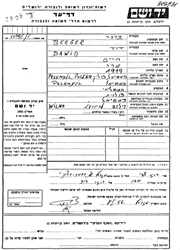
The Story of David Berger
David Berger was born and grew up in the Polish town of Przemysl. When the war broke out, in 1939, he fled from the invading German forces, ending up in Vilna (Vilna became part of independent Lithuania in 1939). While in Vilna he corresponded with his friend, Elsa, who had managed to leave Poland for British-controlled Palestine in 1938. In this postcard he bid Elsa farewell, assuming that he would not survive. In June of 1941 Germany invaded Lithuania.
David was shot in Vilna in July 1941. He was 19 years old
Statement of the Vilnius Yiddish Institute
August 11, 2008
As you may know, over the weekend, anti-Semitic graffiti was painted
on the Lithuanian Jewish Community building at Pylimo 4. The Vilnius
Yiddish Institute condemns this vandalism, and expresses it solidarity
with Lithuanian Jewish Community's leadership, staff and members. We
urge Lithuania's Police do their utmost to quickly identify and bring
to justice the hateful people who committed this crime. The Vilnius
Yiddish Institute appreciates the strong statements of condemnation
from President Adamkus and Prime Minister Kirkilas and urges them to
take the steps needed to put an end to anti-Semitic expressions that
are injuring democracy in Lithuania and harming Lithuania's reputation
internationally. Here are the statements from the President and the
Prime Minister:
The President Valdas Adamkus on Monday, August 11, 2008 stated:
Contempt targeted at the nation which has suffered from genocide is
not casual hooliganism. It is a destructive and sordid act against
Lithuania as a whole, not only Lithuania's Jewish community. I
underline that there is no, and will never be, room for hatred and
instigation of discord in Lithuanian society. I have no doubt the
organisers and perpetrators of the act will be identified and
punished.
At the time when the traditions of tolerance and respect for human
rights are being consolidated in Lithuania and when Lithuania is
helping other states to consolidate freedom and democratic values, I
consider such disreputation of our country a harsh provocation against
Lithuania.
I call on all people of Lithuania to be intolerant to the instigation
of hatred whatever form it may take. It is only through our joint
efforts and strong condemnation of instigation of intolerance that we
can create a safe, open and European-like Lithuania of the
twenty-first century.
The Prime Minister Gediminas Kirkilas on Monday, August 11, 2008
stated: The Lithuanian Citizens of the Jewish desent had contributed
a lot to the making our Homeland famous. The tragedy of the war time
Holocaust has to remind everybody how disastrous is policy of racial
and ethnic hatred. The so called „patriots" making antisemitic
graffiti on the walls and writting in the internet comments with
racist phraselogy actually hate Lithuania and make harm to her.
THE ASSOCIATION OF JEWS FROM VILNA AND VICINITY IN ISRAEL
Taken from “ Jews of Lita”
By Israel Kloizner, Ph.D.
Translated from Hebrew by Eilat Gordin Levitan
Table of content;
Establishment of the Town
Struggles With Local Population
Census of the Year 1645
The Rulings of the 1650s
Continuing Struggle with Local Residents
Jerusalem of Lita (Lithuania)
Under the Russian Rule, 1794-1914
Some Jewish Statistics
Jews in Commerce and Industry
A Cultural Center for the Jews of Eastern Europe
The First World War in Vilna ( 1915- 1918)
Times of Transition to Polish rule ( 1918- 1920)
Under the Polish Rule (1920- 1939)
Under the Lithuanian Rule (October, 1939- June 1940) and Soviet Rule (June 1940- June 1941)
Natives of Vilna;
Rabbis and Torah Personalities
Other Well-Known Jewish Citizens of Vilna
Vilna’ war refugees; 1939 – 1940
----------------------------------------------
Establishment of the Town
The town of Vilna (in Lithuanian, Vilnius, and occasionally also known as Wilna) was founded at the beginning of the 14th century, approximately in the year 1320. Very rapidly, it became a central town in Lithuania, both as its strategic and commercial headquarters. The municipal officers relocated here, and in 1387, the Grand Prince Jogaila gave Vilna autonomy, similar to the autonomy of Magdeburg. According to this bill of rights, the local population had a right to commerce, handcrafts, and positions in the local municipality. Only town residents, however, were granted these rights.
By the end of the 14th century, three central Jewish communities existed in broader Lithuania. These were located in the towns of Grodno, Brisk and Trakai. Vilna, however, was nigh on impossible for the Jews to settle in, because only the original residents had rights to commerce and work there. Nevertheless, some Jews came as guest merchants as well as to work in the public municipality.
Beginning of the Jewish Community
It is said that the old cemetery in Vilna was built in 1487, although there is no written proof of such. In the year 1527, the local Christian population of Vilna received exclusive rights from the old King Sigmund; according to these papers the Jews were not allowed to be merchants or to live in the region. We may assume from these documents that law was passed after the Jews began settling in Vilna to engage in commerce. The Jews, however, could not let go of such an important administrative and commercial center and kept looking for some inconsistency in the special rights that Christian residents received. Slowly they were able to find such ‘cracks’ in the document and settled legally in the town.
The Lithuanian prince Jogaila (at this point also the King of Poland) needed the assistance of certain Jews who were very well-off and knowledgeable in particular fields; in return for their assistance he bestowed upon them rights to manage the mint in Vilna and collect taxes. These Jews lived in Wilna legally. In the year 1551, King Sigmund August I of Poland (succeeding King Jogaila) permitted two Jews from Krakow to become merchants in Vilna; he gave similar rights to his Jewish assistants. These Jews were allowed to rent homes, own stores and warehouses, and to barter goods. Such special rights began breaking the rigidity of the old codex from the year 1527, which had banned all Jews from such endeavors. In addition, the gentile nobility helped the Jews in their quest to reverse the old restrictive settlement laws. The Lithuanian Council (Seimas) gave, in the year 1551, special exemption from taxes to Jewish assistants to King Sigmund owning houses in Vilna.
Many Jews began to reside in these houses owned by the noblemen, working in stores and other commercial endeavors for the Grand Prince. It is thought that they built the first synagogue in Vilna around 1553. Increasingly more Jews moved here, forming a community that economically threatened the gentile population, who feared commercial competition from the Jews.
In the year 1592, some of the local Christians staged a small pogrom, destroying the synagogue, stalls, and apartments of the Jews in a street already then named Jewish Street. Using this pogrom as example of Christian hostility, the Jews convinced the King to give them complete legal rights to settle in Vilna. A year later (in 1593), the Jews received from Sigmund III, in a special bill of rights, a permit to live in Vilna. They were granted residence in the homes of the nobility, freedom to practice their religion, and permission to engage in commerce. After some time, Jews also received permission to establish public institutions for their community, such as a cemetery, a bathhouse, and a slaughterhouse. It is only at this point that the Jewish community came to be recognized as fully legal in Vilna.
picture 2 ( same as 1- cut another way)
Struggles With Local Population
This original bill of rights did not solve all the obstacles that the Jews of Vilna faced in regard to commerce and work. There was nothing in the bill in regard to handicrafts. The Christian population insisted on exclusivity in such work and fought any gap in their monopoly, using even violence and physical force against those Jews who tried to engage in handicrafts. The heads of the Jewish community of Vilna tried to appeal to the King for greater rights; simultaneously, they also asked for assistance from the nobility in receiving such rights. The Jews could easily have been more successful in business and in establishing themselves given the condition of free competition, but they were permitted to have only meager earnings at the time. It was in the interest of the nobility, who wanted to receive cheaper merchandise, to weaken the powerful Christian merchants and aid the ambitious Jewish workers.
Thus, in the year 1633, the heads of the Jewish community received a basic bill of rights from King Vladislav IV. The king not only reinstated the rights they had received earlier, but also allowed the Jews to own stores, open craft-stores, and to engage in liquor, leather-goods, and fur manufacturing. Furthermore, they were permitted to purchase and raise livestock in Vilna. This bill of rights contains the first mention of establishment of a small living area for the Jews. The creation of a ghetto was a new concept, designed to protect the Jews and aid them in the case of a pogrom. However, the Jews did not want to be contained in a small area. In the original bill, they were given 15 years to establish a ghetto, but they extended this date continuously.
During these years, a few of the most important Jews of Vilna succeeded in establishing a certain freedom of commerce for themselves in Lithuania. The king granted such a bill according to the wish of the nobility. The new bill ran as follows:
(1) Jews are allowed to open 12 stores whose fronts open onto Jewish Street. In these stores, the Jews are allowed to sell various merchandise. This right is valid for ten years. Certain merchandise will be limited. For example, liquor is only permitted to be sold to the Christians in mass quantity (not for individual sale).
(2) Jews are permitted to have professions only where there is no Christian competition. In other crafts, they are only allowed to pursue the craft to satisfy their own needs.
(3) The area designated as the ghetto, will be enlarged. Jews need pay no tax to the local municipality but are required to pay state tax. In addition, they must pay a yearly sum of 300 Zloty, which, during wartime, is increased to 500 Zloty.
The local gentile population greatly opposed this bill, and in the year 1634 (and again in 1635) they carried out pogroms against the Jews, destroying the Jewish cemetery and the synagogue. The investigative committee appointed by the king to examine the details of these pogroms did not succeed in finding the locals guilty of these crimes. They reported that the pogroms were carried out by anonymous vandals, and appointed the local municipality responsible for defending the Jews. In consequence of the pogroms, the Jews were allowed to construct gates guarding the streets they settled in. To compensate the Jews for their losses, the municipality permitted them to sell liquor in twenty homes instead of the previous twelve. The yearly taxes to the municipality, however, were increased to six hundred Zloty. Once again, Jews were permitted to operate their stores for ten upcoming years. Before much time passed, the Jews were able without much tribulation to receive an extension on this store ownership, in spite of the bitter opposition of the local Christian population.
Census of the Year 1645
In 1645, the town of Vilna published statistics about local Jews. The leaders of the community walked through the ghetto and several neighboring streets, registering each house containing Jewish residents and those houses that were for sale. This highly imprecise census found that there were 262 Jewish families living in the ghetto. If we estimate that each family was composed of five people, we may assume that there were 1310 Jews living in Vilna at the time. Since most of the Jews lived in the concentrated area aforementioned, the census did not take into account those living under the fortress (in Lithuanian, vyskupija). Taking this into consideration, we may more accurately estimate that there were in reality around 3000 Jews living in Vilna at the time of the census. In contrast, there were around 12000 Christians living here at the time.
The Rulings of the 1650s
Originally, the rulings of the 1650s did not affect the Jewish community of Vilna directly. Eventually, however, the changed conditions that affected the Jews of southern and eastern Poland began to affect the economic situation of Jews in Vilna as well. The Jewish refugees that came now to work in Vilna increased the number of people competing for work. The original Jewish loaners of money now became needy of money themselves. The heads of the Vilna Jewish community borrowed large sums of money from Jesuit priests, giving them rights to their homes and membership to their synagogue.
In 1655, troubles overcame Vilna. The Muscovite army invaded the town and most of the community fled, traveling to Zamut and from there to Prussia. On the border of Prussia, the refugees encountered the Swedish army that had invaded Poland. While the Swedish army demanded certain levies, the Russian army that had invaded Vilna killed many of the Jews and burned the town. The fire lasted seventeen days, and the Jewish quarter was burned to the ground. Destruction of the community lasted until the Polish army liberated the town in 1661. The local Jews then returned to the area and began to recreate their community.

Picture 3.
Continuing Struggle with Local Residents
The reestablished Jewish community of Vilna was very poor and needed much assistance. The kings of Poland helped these Jews by giving them license to rent apartments in all areas of the town and to sell tax-deductible liquor. They also extended the Jews’ loans, decreasing the amount of interest owed. In addition, they gave Jews more permits to own stores opening onto non-Jewish streets. The local Christian population, however, once again fought against this assistance of the Jews, wishing to rid themselves of any professional competition from the Jewish merchants and craftsmen. They continued to file complaints regarding the Jews to the judicial system, sometimes taking the law into their own hands by molesting and hindering Jews. Still, a compromise had to be reached, and the Christians granted the Jews a limited amount of rights.
This trade conflict was exacerbated after the establishment of Christian trade unions that placed very strict limitations on Jewish tradesmen. After Jews complained to King Michael Wisniowiecki, he issued an order wherein it was restated that, according to the ruling of 1633, Jews were permitted to engage in all trades and crafts that were not under Christian monopoly that year. Such crafts included fur-trading, embroidery, and glass-blowing. The Christian trade union reached a compromise with Jewish tradesmen by limiting the numbers of Jews allowed into particular professions and by exacting dues from those practicing certain professions. In consequence, the Jewish tradesmen organized their own societies to protect their business interests. According to the ruling, Jews were allowed to enter only one Christian trade union – that of the barbers.
Despite this skewed compromise, occasionally the local Christians would organize assaults on the Jews of Jewish Street. The various Polish kings, however, attempted to defend the Jews. Such assaults mainly caused destruction of personal property, although a few Jews were killed in these incidents.
During the end of the 17th century and the beginning of the 18th, the Vilna area experienced many hardships: wars, starvation, fires, and epidemics. During the Great Northern War (1700-1721), both the Swedish and Russians entered Vilna, exacting fines and demanding taxes of the residents. The Jews, too, had to pay large sums of money to the incoming armies during the years of 1702 to1706. In result of the war, the years between 1708 and 1710 saw starvation in the area, culminating in1710 with an epidemic killing many in the town, amongst them Jews. Many large fires followed, some of them spreading in the Jewish quarter. Fires in the years 1737, 1748, and 1749 leveled the synagogue and Jewish public institutions.

Picture 4
Despite the difficulties of the Jews and others at this time, the Christian population never stopped fighting for exclusive rights. In the year 1713, many trials were held incriminating the Jews. The leaders of the Jewish community, however, prevented the resulting judgments and sentences from being carried out.
In the year 1738, King August III issued the Jews a new bill of rights for the coming twenty years, allowing them to once again own stores and sell hard liquor. Once more, the Christian population fought these rights bitterly. The municipal authority sued the Jewish community in the court of the king, the primary complaint being that the Jews had deceived the king. These gentiles tried to reestablish the rules discriminating the Jews that had been set forth over a 100 years previously and in 1740 they received a judgment in their favor. This judgment was based on that of 1527. Accordingly, the Jews were no longer permitted to reside in Vilna. Many left the town before the end of the trial, contributing to the biased nature of the verdict.
Thus, the Jews of Vilna faced exile yet again. The Christians attempted to evict the Jewish merchants and craftsmen from the town. However, the minister of the region came to the help of the Jews, establishing a committee to examine both sides of the issue and reach a compromise. A long and tortuous debate began. The side of the Christian townspeople prevailed, and the Jewish community saw no choice but to sign a compromise that was very biased. This compromise delayed the ruling of 1740 (stating that Jews must leave the town because they had deceived the king) but did not fully abolish it.
In light of the compromise, the entire Jewish community became responsible for each Jew who disobeyed its rulings. In this way, the contract ultimately became very helpful to Jewish commerce. Nevertheless, Jewish tradesmen ignored the ruling at the time it was issued, opening large stores with fronts that faced non-Jewish streets. They continued selling what they wished and taking part in whatever crafts they specialized in, and even going so far as to enlarge the area of the prescribed Jewish settlement. When the municipality realized that the Jews were not acting according to agreement, they renewed the battle against them. The Jews began defending their position, fearing exile. Their strategy was offensive, and in the year 1756 the judicial code of the king decreed that the contract from the years 1742 was valid. In a sense, the Jews had prevailed, although they were very limited by this contract.
In the year 1783, the trade unions and leaders of the Jewish community arrived at the courthouse of the king. Among the heads of the community, Arie Leib Myetes’ was very efficient at this task, finding an ally in the assistant to the counselor, Joachim Harptovic, a very educated and enlightened man. Working with him, the ultimate judgment was made in the spirit of progress and liberation. It established new rules concerning the ghetto, stating that Jews need not live in a limited area of the town, as their number had greatly increased and the three narrow streets designated to house them a hundred and fifty years ago were no longer sufficient (these streets still remain under the names of Zhydu, Sv. Mykolo, and Mesiniu Gtv.). Now they were allowed to reside in all areas of the town with the exception of two streets (from the gate of Ostrabrama to the Christian cathedral and from the Trakai gate to the St. John Church). Even in these two streets, Jews already living in houses were permitted to remain. Also included in this ruling was the pronouncement that Jews living in these streets must contribute to the beautification of the town.
New edicts concerning taxes declared that Jews’ taxes would equal those of all other citizens, and the yearly tax of 600 Zloty was abolished. The ruling also established the freedom of Jews to participate in all commerce and craftsmanship, explaining that the contract of 1742 was a product of its time and its conditions could and would no longer be sustained. The ruling of 1783 also clarified that each person wishing to receive a license for craftsmanship would be tested by a committee that would be composed of both Jews and gentiles and would be appointed by the municipality.
This judgment was regarded as a big victory by the Jews of Vilna. In commemoration of it, the gravestone of Arie Leib Myetes’ reads “it is he who saved the Jewish community in the year 1783 and averted disaster in town through his cleverness.” The bill of 1783 ended a long struggle for Jews’ right to live, work, and engage in commerce in Vilna. Jewish commerce and trade increased, and many unions of Christian workers were terminated. Ultimately, the ruling legalized something that was long in existing and removed the obstacle of free progress in commerce and craft by the Jews.
Jewish Censuses at the End of the 18th Century
In order to determine accurate taxation, censuses were carried out in Vilna in the years 1765 and 1784. After Vilna was conquered by Russia, there were yet other censuses in the years 1795 and 1800. While these censuses are not accurate, we may still learn much from them. The most exact censuses were taken in 1765 and 1800. According to the census of 1765, the Jewish community of Vilna and its suburbs was compromised of 3887 individuals. In the year 1800, 6971 individuals inhabited the same area. The total number of residents at the end of 18th century, including the Jews, was 17351 individuals. Thus, the Jews composed almost half of the total population at the time.
Internal Jewish Politics During the Years of the Polish-Lithuanian Kingdom
The Jews had become autonomous and their leaders served in a committee, chosen by the community to represent them in the larger population and negotiate with the local government. They collected taxes, had formed their own judicial system, were responsible for the health and sanitary conditions of the Jewish quarter, and supervised Jewish education. Each year, new community, judicial, and religious leaders were elected by the community. In certain job areas, such as education and health, special societies existed (Talmud-Torah for education, Bikur-Holim for Health Care, and CHK). Each such society elected its own leaders.
The Vilna Jewish community began to take part in the Committee of the State of Lithuania for the first time in 1652. In time, it became very prominent in this committee, since the Jewish quarter had became a significant metropolitan area of the town. Taking example from the Christian craftsmen, the Jews also organized trade unions. At the head of the society of weavers was CH. K. Schmuckler. The number and size of such societies increased steadily. Most such groups attempted to establish their own synagogues.
There existed a noted hierarchy among the leaders of the community. In order of importance, these leaders were: the rabbi, the av beit din (religious judge), the magid, the writer of official documents, the beadles, the legal community representative (shadlan), the doctor, and other community workers. It was the wealthy and the learned who influenced the community the most. Only well-to-do or learned individuals were elected as leaders of the committee and societies. Even in difficult times when the community required representatives reflecting their decrepit state, those elected were wealthy. They in turn elected their relatives for more minor judicial positions.
Originally, the community was ruled by volunteers who cared for the betterment of the public. Among them was Eliyahu Hasid, brother of Yisaschar Bar, son of Rabbi Moshe Kramer (av beit din of Vilna, died in 1688), and great-uncle of the ‘Genius of Vilna’ (1720-1797). Another like him was Yehuda S”od (son of Eliezer, died in 1763, was the father-in-law of Shmuel, son of Avigdor, av beit din of Vilna). Following this type of rule, the job fell to the hands of the wealthy, who wanted power and control. Consequently, a great debate started in the second half of the 18th century between the av beit din Shmuel, son of Avigdor, and the head of the community, Abah, son of Ze’ev Wolf. The Jewish craftsmen opposed the head of the community, and their representative demanded either the abolition of the leading committee or at least a limitation of duties to religious and charity work. Both sides, for the first time, appealed to the government. The autonomy of the Jews, however, was greatly hurt by appealing to outside help in settling a local debate.
Jerusalem of Lita (Lithuania)

picture 5
As the Jewish community became more established in the first half of the 17th century, Vilna became the center of the Torah. Many religious learned Jews from other places, such as Bohemia, Austria, Germany and Poland arrived here. Moshe Rivkas’, son of the writer and scribe of the Jewish community of Prague, brought with him to Vilna the library that had belonged to his father, collecting many new works as well. Many at the head of the religious community were well-known, amongst them famous rabbis such as Moshe Lima (son of Yitzhak Yehuda, died in 1670) who wrote the book “Chelkat Mechokek” that became renown throughout the Diaspora. The religious judges in Vilna at this point were Ephraim (1616-1678, son of Yaakov The Cohen, “Shar Efraim”), Shabtai Cohen (son of Meir The Cohen, 1622-1663) Aaron Shmuel Keidanov (known as the Ma”hrshk, 1614-1676, born in Kedainiai), and Hillel (wrote Beit Hillel, born in Galicia, religious judge in Vilna). Due to the destruction of the community in 1655, many of these learned men fled and settled in the west. Some of them received jobs as rabbis in important Jewish communities. Rabbi Shah Shabtai Cohen became the rabbi of Holesov in Moravia. Ephraim, writer of “Schar Efraim” also became a rabbi in Moravia; Aaron Shmuel Keidanov became rabbi of Pielt in Germany; Hillel became rabbi in Altuna, Hamburg. Eventually, rabbi Moshe Rivkas’ (son of Tzvi Naftali, died in 1671) returned to Vilna from Amsterdam, where he wrote the book “Be’er Hageola”.
Slowly, the community returned to its prominent cultural and religious position, and in the 18th century Vilna again became filled with Jewish writers and learned men: Yaakov Amdan wrote a book about the learned men of Vilna during that time (Megilat Sefer: “Better known and more glorious than all Polish people, they were the most devout learned men and did not leave the house of prayer and learning and would instead sit there day and night with their books They became a den of lions of the Torah, all of them received positions of the teachers of Israel”)

Picture 6
Special among these learned men and writers was Eliyahu Hasid Ben Solomon, who became better known as the Genius of Vilna (1720-1797). He strengthened traditional Jewish values, keeping them insulated from the new movement that was taking form in the Jewish streets. Nevertheless, the upcoming movements took root, examples being the Hasidic movement, established by Baal Shem Tov, and the enlightenment movement that came from Berlin under the influence of Mendelssohn (the grandfather of Mendelssohn the musician). Only a small number of the heads of the Vilna community of the learned were affected by the Hasidic movement. This is due to the work of Rabbi Eliyahu, who stubbornly resisted it.
Already the first of these enlightened Jews of Vilna worked to preserve the Hebrew language. Taking great interest in its grammar, they were also curious about modern additions to the religious text. They continued its tradition, preferring it over philosophy. Vilna, with its rabbis, writers, philosophers, and educated people, became renowned as the center of spiritual life of the Jews of Lithuania. Thus, it was rightfully named the ‘Jerusalem of Lithuania’ (Yerusholayim de-Lita).

picture 7
Under the Russian Rule, 1794-1914
In 1794, around thirty Jews were killed in a Vilna suburb by the incoming army of the Russian empire. In 1812, the French army conquered the town and the Jewish population suffered greatly. The old cemetery became a pasture for cows and sheep. The Jews helped the Russian army to fight the French, hoping Czar Alexander the First would improve their situation. This was a misconception, as the situation during the rule of the brother of Czar Alexander Nikolai the First was very bitter. A draft claimed young Jewish children for the army, causing great alarm in the community. Despite many of Jews’ pleas, this order was not revoked and greatly hurt the population, resulting in internal struggle in the community because it was the leader of the community who were responsible for fulfilling the specifications of the draft. The governing committee secretly kidnapped impoverished Jewish children to fulfill the requirement of the draft, causing the population, especially those who were poverty-stricken, to revile the leaders of the community.
In 1802, an order came to the Russian-occupied Vilna stating that a certain number of Jewish representatives must be chosen for the municipalities, as was custom in the Russian empire. The chief of the central municipality greatly objected to the members of the Jewish leading committee. Thus, after pleas of the Jews to revoke this order, it was cancelled by the municipality. The subject was again brought to light in 1816. The mayor of the Vilna region suggested that some Jews assume positions as representatives in the municipality, and so in 1817, two Jews were chosen for this general committee. Seven of the gentile members of the committee announced that they would not take part in any organization that contained Jews. The gentiles were put to trial for refusing to work with the Jews, although the outcome is not known.
The Jews remained in the general committee until the year 1820, when the Russian leadership acquiesced to the pleas of the gentiles in forbidding the Jews to take part in the committee. Once again, this issue was debated for a long time – until the year 1836 – when it was finally decided that Jews would no longer be allowed to participate in the committee of Vilna. Although this decision was an exception amongst the rules applying elsewhere, during the entire period of Russian control of Vilna, Jews were not members of the leading committee. It was only according to the Law of 1892 that a few Jews were permitted to join the committee, although even then they were not allowed to take active part in its decision-making and work.
In 1844, Russian rulers annulled the autonomy of the Jews over their affairs. The beadles of the synagogues became the caretakers of the social and religious life of the community. The beadle of the largest synagogue became the head of the community. By the 1840s, the situation of the Jews under Russian rule had become very difficult, and in 1846 a renowned Jew by the name of Moshe Montefiori (1784-1855) came from the West to plead with the Czar to revoke a new ruling hindering the Jews. During his visit to Russia, Moshe stopped in Vilna, where he was received as an honored guest by the local Jews. He investigated the situation of the community and received detailed written reports from educated Jews living here. Despite Moshe’s pleas, however, the Czar did not revoke the ruling.
In the year 1850, yet another ruling came from the Czar, this time in regards to the costume of religious Jews. Now, Jews were forbidden to wear long gowns such as those of Polish Jews. In addition, rulings regarding traditional men’s sideburns and women’s wigs were issued. Most in the Jewish population strongly objected to the ruling, although they eventually became accustomed to the new fashion.
Following the demise of this evil Czar there was improvement in Jews’ life in two areas: that of army service and of permission for Jews to breach the Pale of Settlement. In the year 1861, the rule decreeing that two streets of Vilna must remain unpopulated by Jews was eliminated. However, a Jewish resident of Minsk by the name of Jacob Barfmann converted to Christianity, causing great damage to the Jewish population. In the year 1866, he arrived in Vilna and published an article suggesting that Jews were a nation within a nation. This article caused great turmoil amongst the Vilna ruling class. Mr. Barfmann was asked to collect testimony from books of the Jewish community showing the ‘true nature’ of the Jews. This appointment caused great turbulence amongst the Jewish population, and the general governor agreed to the suggestion of a Jewish publisher from Vilna, Yaakov Barit, founding a committee of educated Jews who would investigate the claims made by Mr. Barfman. This committee existed until 1869. Despite the fact that Yaakov Barit was successful in proving to the members of the committee that the claims that Barfman made were false, Barfman continued in his activities and published, with the help of gentile authorities, a book about the Jewish community. This propagandist and fallacious book insinuates that according to faulty interpretation, the books of the Jewish community are erroneous in regards to the true nature of the Jews. Barfmann’s book was sent to many government officials and was used by its clerks as an official document describing the Jewish community and their relation to the state.
During the reactionary period when Czar Alexander III came to power, Jewish Vilna was very involved in a movement for equal rights and national liberation. In 1872, Vilna established the first Jewish Social Center in the world. In addition, one of the first Zionist Unions, Hovevei Zion (From its inception, the Hovevei Zion groups in Russia sought to erect a countrywide legally recognized network. After negotiations, in which the authorities demanded that the society be set up as a charitable body, its establishment was approved, early in 1890, as ‘The Society for the Support of Jewish Farmers and Artisans in Syria and Eretz-Israel,’ which came to be known as ‘The Odessa Committee.’), was established here in 1882. In the year 1897, a meeting was held for the entire committee of the Social Democratic Jewish Party (the anti-Zionist Bund – “Like other Jewish Marxists, the Bund argued that, rather than emigrating to Palestine, Jews should combat racism wherever they were. So it was extremely hostile to Zionism, which it saw as a refusal to fight anti-Semitism – and indeed a concession to it.”
Taken from http://www.sa.org.au/cgi-bin/index.cgi?action=displayarticle&id=214).

picture 8
Young Bundists in Vilna. The original caption reads, "taken before Leike Zafron went away." Among those pictured is Etta (Miransky) Michtom (second row from the top, third from the right)
.
During the Russian Revolution of 1905, this party became very active in Vilna.
In 1902, a young Jewish shoemaker by the name of Hirsch Leckert (1879-1902) attempted to assassinate the Vilna governor, von Wahl, who had been very cruel to protesters on May 1st. The governor was wounded, and Hirsch Leckert was hung. During the same year, the religious Zionist organization held a meeting in Vilna. The city became a center for the laborers of Zion. In 1903, Doctor Herzl, president of the Zionist movement, stopped in Vilna on his way to St. Petersburg. This visit resulted in a great demonstration of Vilna Jews in support of Herzl and his doctrine. Between the years 1905 and 1910, Vilna was the location of the Zionist Committee of Russia. In 1906 Vilna witnessed a meeting of the Union for Equal Rights of Russian Jews; Doctor Shmaryahu Levin was elected as a representative to the Russian Duma. At this point, he lived in Vilna.

Picture 9. Delegates to a congress of the Tse'irei Zion movement, Vilnius 1921. Shlomo Farber (front row, second from the right); Menachem Rudnicki - Adir (front row, fourth from the right); Chaim - Shalom Kopilowicz (front row, third from the left); Avraham Solowiejczyk (front row, on the left); Lewin (standing, second from the right; first name unknown), a delegate from Molodechno; Israel Shafir (standing, third from the right); Nachum Kantorowic (standing, fourth from the right); Israel Marminski - Marom (standing, fifth from the right); and Margolis (standing, fourth from the left; first name unknown), a delegate from Svencionys. Also in the photo, seated: A. Katz, Shraga Antovil, Reuven Boniak, Shlomo - Yitzhak Alper, Eliahu Rodnicki, Nechama Horwic, Yitzhak Walk, Chaim Fejgin, and Yitzhak Schweiger, a Zionist emissary from Mandatory Palestine.
Some Jewish Statistics
The number of Jews in Vilna steadily increased during the 19th century. By 1832, Jews constituted the majority of the town population. While Vilna housed 20706 Jews, it was the residence of only 15200 gentiles. According to the census of 1897, of 154532 Vilna inhabitants, 63997 were Jewish; Jews made up 40.9% of the population. In 1916, Vilna’s inhabitants had decreased to 148840, yet amongst them were 61263 Jews, or 43.5% of the general population.

picture 10
Jews in Commerce and Industry
Vilna soon became a center of commerce and industry. The town’s merchants shipped products to distant markets all over the Russian Empire. Vilna also became a transit station for the merchandise traveling between Russia and Germany. The local manufacturers, specialists in their professions for generations, developed contemporary products, such as mass-produced ready-made clothing and gloves. In the surrounding neighborhood of Vilna, they also generated wood products, using mills and factories to make furniture. Vilna residents controlled flour mills, beer and tobacco factories, sweet and sugar factories, and printing presses as well as tanneries. Jews took increasingly large part in such commerce in the 19th century. In 1806, only 22.2% of merchants were Jewish. By the year 1827, Jews made up 75.6% of merchants: almost the entire commerce in Vilna had passed to Jewish hands. By 1875, of 3195 merchants, 2752 were Jews, or about 86%. In 1897, 77.1% of merchants were Jewish.
Particularly large was the number of Jews who owned small stores and businesses. According to the census of 1897, the professional classification of Jews of Vilna was as follows: merchants – 6117 individuals; industry and manufacturing – 13573; transportation – 875; agriculture – 78;doctors, lawyers, and the like – 1026; others – 6926. Accordingly, most Jewish residents of Vilna were involved in industry and production. These small-time Jewish manufacturers began exporting their goods - ready made clothing and gloves - to all areas of Russia.
In 1914, according to a census carried out by Jacob Laszcinski, more than 50 manufacturing enterprises belonged to Jews; in each one of them worked more than ten people. In some of these, there were twenty and in others as many as forty laborers. Small manufacturers yet abounded. That year, of 131 Jewish glove-makers, 78 employed 308 laborers and 125 assistants. Other than these laborers, between 250 and 300 workers, mostly women, carried out small assembling jobs from home.
In the sowing industry of 1914, about 1000 Jewish enterprises existed, collectively hiring around 2000 laborers. Ready-made clothes were sent to Caucasus, Siberia, and central Russia. Vilna’s main competitor in the clothing trade was Poland. These sowing assemblies operated very similarly to US enterprises, with detailed division of labor. 200 ready-made clothes manufacturers hired between 500 and 600 laborers; some establishments employed 30 or 40 laborers alone. Of around 100 shoe-makers, only three were gentile. Collectively, 500 Jewish workers were employed in the shoe-making industry. Three to four thousand additional laborers made socks; many worked from home. Other professions – such as those of hatters and saddlers – were a Jewish monopoly.
In 1815, the first Jewish factory was opened for the production of simple cloth. By 1858, almost all factories were owned by Jews. Although they were not large, the 43 factories employed 210 laborers. During the years from 1870 to 1880, this industry was much encouraged by authorities. In 1887, 53 of Vilna‘s factories were operated by Jews; together they used the services of 1469 manual workers. Although ten years later the number of Jewish factories had decreased to 49, they now employed 2378 laborers. Just before World War I, the number of Jewish factories increased to 125 and the number of laborers to 4671. Other than the fields already mentioned, there were no truly developed industries in Vilna.
As Vilna was a center of commerce, sectors of important banks were opened here. Jewish merchants and tradesmen opened their first savings and loan bank in 1904. The previous year, in 1903, Doctor Benjamin Pin, the son of Räshi Pin, left in his will some money to assist in manufacturing and subsequently became very important to the industry. His example was followed by similar benefactors in other Russian towns.

picture 11
A Cultural Center for the Jews of Eastern Europe
Vilna continued to flourish as an eminent cultural center throughout the 19th century. It was the center of the Torah; the Enlightenment spread through the town and its environs. While many distinguished writers and progressive thinkers were raised in Vilna, others came from different towns. In the middle of the 19th century, it became a hub of Hebrew literature.
A central personality amongst the free-thinking inhabitants of Vilna was the writer Mordechai Aaron Ginsburg (1795-1846, born in Salant);
among poets who originated in Vilna we must mention
Avraham Dov Hakoyin Levinsohn (born in Vilna in 1794, died in 1878) and his son Micha Yosef Levinsohn (1828-1852) as well as
Schlomo Zalkind (died in Vilna in 1868) and
Yahudah Leib Gordon (born in Vilna in 1830, died in St. Petersburg in 1892). Vilna also housed researchers the likes of Matityahu Strassen (son of Shmuel, born 1818 in Vilna, student of teachers from Lebadova and Ilya, died in 1886 in Vilna),
Yitzhak Isaac, son of Yaakov,
Avraham Zagheim (died in Vilna 1872, son of Yosef),
Smuel Yosef Pin (born in Grodno 1819, died in Vilna in 1890),
Eliezer Lipman Horowitz (born in Vilna in 1815, died 1852),
Juhoshua Steinberg (born in Vilna in 1839, died in 1908). Also there were welknown writers like Kelman Schulman (born in 1821, died in 1899 in Vilna),
Benjamin Mendelstamm (born in 1800 in Jagar, died in 1886 in Simpropol),
Isaac Meir Dik (born in Vilna in 1807, died in 1893),
Moshe Reicherson (born in Vilna in 1827, died in 1903),
David Moshe Mitzkohn (born in 1836, died in Vilna in 1887),
AY Papirna.
The well-known writer Mapo (born in Slabodka in 1908, died in Konigsberg in 1867) belongs very much with the Vilna literary spirit. These scholars wrote in Hebrew, the literary language of the Jews of Eastern Europe. Eventually, the Yiddish language, the vernacular among Jews, also became a literary language, furthered by writers such as A.M. Dik and Michail Gordon. The common sharp humor of the times was expressed by the national comedians Motke Habad and Sheike Feifel, the flute-player. Members of a well-to-do enlightened class, such as Eliezer, Nisan, and Moshe Rosenthal, Mordechai Nathanson, Elazar Halberstamm, and others, also lived in Vilna at the time. What is particularly evident amongst these writers is their deep-rooted love for the Hebrew language as well as for the Bible and the land of Israel. In addition, they recognized the unity of the Jewish nation that had spread out during the Diaspora and had a deep love of traditional literature.
In the year 1799, two printing houses transferred from Poland to Vilna. Both had Hebrew divisions. In the publishing house of the Polish Zawadski, the head of the Hebrew department was Menachem Man, who changed his last name to Romm. In 1835, Romm began printing, in partnership with a few wealthy Vilna residents, the Bible. At the same time, the Bible was also printed in the Sloboda printing house. A fight ensued and was taken to court, where it was decided that the printing house of Romm would be the sole publisher of the Bible. In consequence of this verdict, the government closed all Hebrew printing presses in Russia with the exception of Romm’s in Vilna and another in Kiev. Romm now had a monopoly on almost all Hebrew literature of the region and became very successful. The Romm printing press was used by the writers of Vilna as a publishing house. In 1863, a new publishing house was opened by Rashi Pin and Rosenkrantz; following this, many other such houses were launched.
Several Jewish students studied in the Polish university in Vilna. In 1808, the university established a program for teachers of secular Jewish schools, but this program existed for only half a year. In 1830, Jewish academia established a secular school in Vilna, but, once again, this did not last long. In the year 1841, a group of educated Jews, headed by Nisan Rosenthal (died in 1816 Vilna, was born in Yasinovka),
established two schools at which children studied both secular and religious topics. In 1844, the government of Vilna opened a school for rabbis that in 1873 became a school for Jewish teachers. This establishment was largely intended to further Russification among Vilna Jews, providing general schooling rather than specifically educating rabbis and teachers. Many students of this establishment became known as writers and researchers. Among these were Dr. Yehuda Leib Kantor (born in Vilna in 1849, died in Riga in 1915),
Doctor S Mandelkern,
Aaron Shmuel Lieberman (born in 1845, committed suicide in 1880 in the US), Abraham Eliyahu Arahbi, son of Yaakov (born in Novohorodok in 1835, and died in 1919),
Kahn Avraham (born in 1860 in Podbraze, died in 1951 in New York), and
L Livender .

picture 12
At the beginning of the twentieth century, a Hebrew high school with a primary language of Russian was established. Under the headmaster PA Cohen, many subjects were taught in Hebrew. The Zionists, becoming more and more influential in the area, established a modern institution for religious studies, and new, modern ideas became more common in the secular Hebrew schools as well. In some, Hebrew began to be taught in a more natural way, often replacing the more common Yiddish. Several Zionist women established at this time a Hebrew school for girls by the name of Jahudija.
At the beginning of the twentieth century, Vilna was the cultural center for many Hebrew writers. Between 1904 and 1915, a daily paper, Hazman (the Times), was published, whose writers included Ben Zion Katz (born in 1875, died in Tel Aviv in 1958), Israel Chaim Tvajov (born in Druja in 1858, died in Riga in 1920), Yosef Eliyahu Trivesh (born in Vilna 1855, died in 1940), Shaul Chernovitz, YD Berkowitz (Ben Zion Yahuda?), Ben Eliezer (nee Moshe Galumbatsky, born in 1882, died in Tel Aviv in 1944), Y. Brashdeski, Hillel Zeitlin, and SL Zitron. Furthermore, a monthly newspaper was published by Zev Yewitz, called Hamizrachi. The weekly of the Zionists, Zionist Congress, was published in Vilna and targeted a youthful demographic. In addition, weeklies like Life and Nature were published by Lavner and Comrade published by Eliyahu Halevi Levin. Yiddish newspapers also flourished. In 1906, the Zionists began publishing a scholarly weekly, named Das Jidische Volk. Its editor was Dr. Yosef Floria. Other political parties, such as the Bund, the Zionist Labor Party, and the Socialists (SS) also published newspapers and books, mostly in Yiddish. The monthly Yiddish World transferred its location from St. Petersburg to Vilna, and was edited by S. Niger. A children’s Yiddish newspaper by the name of Grininka Biamelah was published by Hilperin Falak. Furthermore, an important scientific library was established in the town. Books were contributed per the inheritance of the learned Matityahu Strassen.

picture 13,
The First World War
The German army took over Vilna during Yom Kippur of 1915. A very difficult period came, a time of starvation and unemployment, followed by forced labor. The previously flourishing industry and commerce were eradicated. Although the town incurred a collective financial penalty of one million Marks, the Germans were not able to collect such a prodigious amount of money from the impoverished population.
During this difficult period, camaraderie flourished in the community. Helped with training of professionals and given employment opportunities, education in the Jewish community progressed and the first Hebrew-speaking high school in the Diaspora was established along with a Yiddish theater. At the end of the German rule, a democratic election of leaders for the Jewish community took place.

picture 14. A bicycle trip for members of Zionist youth organizations in Vilnius. The bicyclists, who set out on May 5, 1920 - the beginning of the Lag B'Omer holiday, carried a blue and white flag with the word "Zion" in Hebrew, and various placards, in Hebrew and Yiddish, with slogans in support of labor and the Jewish People's return to the Land of Israel
Times of Transition
At the end of 1918, the Germans retreated from the town. Local Polish citizens received leadership positions from the Germans, but a few days later, the Red Army invaded. Communist rule lasted for only a short time, but even in that time industry and commerce greatly suffered. The Communists took over many businesses and the situation of the Jews of Vilna became dire.
On April 19, 1919, the Polish legionnaires entered Vilna and began molesting Jews. However, the commander of the Polish army, Pilsudski (1867-1935), immediately announced that the duty of the army was to liberate the city and to give its citizens the opportunity to manage business as they saw fit. He instituted a democratic election and several Jews were elected to serve in the town council. On the 14th of July, 1920, the town once again was invaded by the Red Army. A day later, Lithuanians entered the town. At the end of that August, the Russians gave control of the town to Lithuanians, who promised the Jews national and cultural autonomy.
Under the Polish Rule

picture 15.
Soon thereafter, the Polish army, headed by general Zaligowsky, conquered the town. Under Polish control Vilna became a backwater Polish town without any commercial inflow. Its connection with the neighboring independent Lithuania was severed. The Jews of Vilna took part in the leadership of the town but were forced to fight for these rights. The duties of the Committee of the Jewish Community were decreased and, according to Polish diktat, became responsible only for religious and social work. Despite this, the Jews covertly conferred upon the committee greater responsibilities.
As the Vilna economy was stagnating, continuous emigration to the United States and other countries occurred. Nevertheless, Jewish schools, taught in both Hebrew and Yiddish, were established. In addition, schools training teachers in Hebrew and Yiddish and Hebrew and Yiddish high schools were opened. Polish authorities, desiring to educate Jews in Polish, opened a Polish public school for Jewish children. In addition, the Polish university in Vilna accepted only students with Polish high school diplomas. Thus, it became very difficult for any graduate of a Hebrew or Yiddish high school to be accepted. Notwithstanding this limitation, many Jewish students attended the university.
The main cultural loss for Vilna’s Jews was its position as the heart of Hebrew literature. The Jews who promoted Yiddish used this opportunity to open their own center and attempt to make Vilna the core of the Yiddish movement. They established several public high schools and a teaching seminary in Yiddish. They also tried to establish a scientific institute for high school graduates. This establishment was intended to carry out research on Yiddish language as well as Jewish history, statistics, and other such subjects. Known as the YIVO, it became famous throughout the Diaspora, but especially in Poland.
On Jewish Street, hostilities ensued between the Zionists and the Bund. While the Zionists controlled the Jewish community, the Bund strongly impacted its trade unions. During the few years prior to World War Two, Anti-Semitism spread all over Poland, including Vilna.

picture 16.
Under the Lithuanian and Soviet Rule
As soon as World War Two began, the Soviet Union occupied a large sector of Poland. Vilna was handed over to Lithuania by the Soviets in October 1939. Under the rule of democratic Lithuania, the situation of the Jews improved. Many Jewish refugees arrived from Poland to seek haven in Vilna. In June 1940, Lithuania was occupied by the Soviet Union. The Soviet rulers now began to deal with those who displeased them in Vilna: public leaders as well as writers and members of the Zionist party and other Jewish parties were sent to Siberia. Among those who were sent to Siberia, a few were executed. These were leaders of the Yiddish, Volkist, movements, among them Zalmand Reizin as well as the lawyer Yosef Chernikhov (also known as Danieli, was born in Slonim in 1882, perished in a Soviet prison in 1941.)

picture 17.
Natives of Vilna
Rabbis and Torah Personalities
-R’ Abraham Zvi, son of R’ Shmuel Isar Hacohen
- R’ Aaron from Vilkumir
- R’ Avraham son of R’ Eliyahu
- R’ Eliyahu son of Azriel
- R’ Moshe Simon Antokolski
- R’ Efraim son of Yakov Hacohen
- R ’Yakov Ashkenazi
- R’ Yitzhak Belser
- R’ Zelig Ruven Bengis
- R’ Bzalel, son Israel Moshe Hacohen
- R’ Israel Ginsburg
- R’ Nahum Grinhaus
- R’ Eliezer Eliyahu Dikes
- R’ Bzalel Dikes
- R’ Shaul Chaim
- R’ Halevi Horowitz
- R’ Avraham Zvi Halperin
- R’ Eliyahu Gershon Halperin
- R’ Yakov Zak
- R’ Israel Zakheim
- R’ Moshe Halevisaksh
- R’ Chaim, son of Shlomo Zalman
- R’ Hillel David Hacohen Traives
- R’ Yehuda, son of Eliezer
- R’ Joshua, son of Yosef
- R’ Chaim Uri Cohen
- R’ Yehoshua Heshil
- R’ Halevi Levin
- R’ Yehoshua Lang
- R’ Eliezer Landau
- R’ Yehezkel Halevi Landau
- R’ Yitzhak Eliyahu Landau
- R’ Yekutiel Zalman Landau
- R’ Alexander Moshe Lapidos
- R’ Noah Mindes
- R’ Hillel Milikovski
- R’ Menachem Eliezer, son of Levi
- R’ Moshe, son of Hillel
- R’ Moshe Ravkash
- R’ Yosef Skovic
- R’ Mordechai Eliezer Kovno
- R’ Zvi Hirsch Kedanove
- R’ Mordechai Klatshkau Melzer
- R’ Abraham Kretchmer
- R’ Shabtai, son of Meir Schah
- R’ Shlomo, son of Israel Moshe Hacohen
- R’ Arie Leib Shapiro
- R’ Yitzhak Eliezer Lipman Shershevski
- R’ Avraham David Strassen
-
Other Well-Known Jewish Citizens
-Alexander Ezra, actor
-Abraham Eisenberg, sculputrer
-Yeshayahu Eisenstadt, leader of the Bund
-Ben Zion Alpers, writer
-Lion Antokolski, artist and educator
-Mordechai Antokolski, sculpterer
-Yehuda Bihak, researcher
-Yaakov Bilikov, public servant
-Yehuda Leib, son of Yaakov Davidovich, doctor and writer
-Jacob, son of Jacob, bibliographer
-Louie Miller, newspaper writer
-Shlomo Bastompski, writer and educator
-Vladimir Baskin, music critic
-Abraham Aaron Broda, writer
-Abraham Broides, poet
-Yitzhak Broides, Zionist political activist
-Ruven Usher Broides, writer
-Yosef Luis Baron, rabbi and professor of philosophy
-Joshua Zev Bertonov, actor
-Aaron Mikhail Borohov, teacher and writer
-Bernard Bernsohn, art critic,( father of Marca Bernsohn)
-Sinaiv Leopold Bernstein, painter
-Ben Zion Yehudah Berkowtiz, writer
-Alexander Berkman, anarchist, partner of Emma Goldman
-Leopold Godovski, pianist and composer
-Shmuel Gorzenski, Bund activist
-Israel Isaac Goldblum, bibliographer
-Ezra Golding, author
-Aaron Gordon, doctor
-Aaron David Gordon, doctor
-Yehuda Leib Gordon, poet
-Yekutiel Gordon, doctor
-Mikhail Gordon, poet and writer
-Aaron Goland, author
-Ilya Ginsburg, sculpturer
-Gabriel Yaakov Ginsburg, financier and donor
-Yaakov Halperin, lawyer
-Chaim Grada, poet
-Avner Griliks, artist
-Avraham Grilisks, artist
-Zvi Henry Gershoni, rabbi and author
-Wolf Dormeshkin, musician
-Israel Dushman, poet and educator
-Shmuel Dykes, researcher
-Isaac Meir Dik, father of secular Yiddish literature
-Shmuel Dikstein, member of the US congress
-Eliezer Lipman Horowtiz, literature researcher
-Genja Horowitz, revolutionary
-Yitzhak Horowitz, author
-Pinkas Eliyahu Horowitz, mystic
-Shlomo Zalmand Horowtiz, author
-Markus Heyman, member of the Canadian parlament
-Chaim Yaakov Helfen, founder of the Bund
-Dvorah Ester Halper, donor and public servant
-Mikhail Halperin, one of the first pioneers in the land of Israel
-Yosef Berger, doctor and researcher of the bible
-Michael Hazkel, financier
-Yosef Wolf, cardiologist
-Yitzhak Witenberg, the leader of the partisan movement during WWII.
-Yosef Vinogrod, singer
-Rahmil Aaron Weinstein, founder of Bund
-Teibe Vinseski, resistance fighter
-Avraham Wirshovski, doctor and author
-Max Waskind, director
-Zvi Valblowski, judge
-Batjah Vernick, writer
-Paritz Vernick, writer
-Hillel Leon Zolotkov, editor
-Aaron Zundelevic, revolutionary
-Rosilia Sara Zeidfeld, mother of Max Nordoi
-Moshe Zilberstein, singer
-Shlomo Zalmand Zelkind, poet and educator
-Arnold Zelkindson, doctor and mathematician
-Yitzhak Eduard Zelkinson, first to translate Shakespeare to Hebrew
-Daniel Havelson, researcher of eastern culture
-Yitzhak Barhonas, lexicographer
-Yasha Heifetz, violinist
-Max Heifetz, biologist
-Moshe Leib Haskes Odenzig, poet and satirist
-Chaim Tebris, merchant and writer
-Kalman Tauber, rabbi and educator
-Yosef Eliyahu Treves, author and educator
-Yishayau Yonah Tcharna, pedagogist and author
-Leon Yagihez Grazovski, (Tishko), revolutionary
-Vladimir Joshelsohn, revolutionary and ethnologist
-Aaron Johnathanson, educator and poet
-Zvi Johnathanson, author and donor
-Benjamin Zajef Jacobson, lawyer and representative in the Duma
-Shlomo Jafe, member of “Bilu”, the first pioneers to Israel
-Chaim Yafim Yasharun, political activist
-Yehuda Leib Cohen, folklorist
-Avraham Dov Levinson, poet and linguist
-Michal Yosef Levisonson, poet
-Imanuel Levi, judge
-Israel Levintal, rabbi and Zionist activist
-Liuba Levison Eysenstadt, revolutionary
-Yaakov Leibowitz, physician
-Yot Lipman Litkin, mathematician and physicist
-Leon Laskov, pharmacologist
-Lisa Magon, resistance fighter
-David Magid, historian
-Hillel Noah Magid, biographer and writer
-Yosef Osif Minor, revolutionary
-Shlomo Zalkind Minor, rabbi and writer
-Chanan Yaakov Minikes, writer and publisher
-David Moshe Mitzkohn, poet
-David Mekler, publisher and editor
-Chaim Zeef Mageliot, rabbi and author
-Chaim Leib Markon, researcher
-Mordechai Nemser, rabbi
-Jonah Bernard Nathanson, physcist
-Mordechai Nathanson, author
-Taubes Segal, midwife
-Leser Segal, painter and illustrator
-Eliyahu Lewis Solomon, rabbi
-Yosef Selkind, author
-Shaul Sapir, journalist
-Asriel, son of Moshe Mashil, linguist
-Abraham Efron, writer
-Eliyahu Efron, publicist
-Yehuda Leib Polikanski, industrialist
-Aaron Eliyahu Pompianski, author
-Gershon Pludermecher, pedagogist
-Eliyahu Pinhas, researcher
-Yosef Paslas, learned man
-Shmuel Paskind, leader of the laborers
-Jahoshua Freedman, author and educator
-Yosef Peres, musician
-Elyakim Zosner, famous national poet
-Israel Schlomo Zipkin, educator
-Sara Kodes, author and midwife
-Avraham Uri Kovner, literary critic
-Mikchail Kovner, resistance fighter
-Shaul Savlikovner, historian of medicine
-Herz Koverski, phycisian and public activist
-Zemah Koppelson, revolutionary
-Avraham Kupernik, businessman and donor
-Yehudah, Julian Klatchko, author (converter to Catholicism)
-Zvi Kirsch Klatchko, head of Vilna community
-Yehudah Leib Kantor, editor and journalist
-Alter Kazisno, poet and dramatologist
-Euriah Katzenelbogen, author
-Abrah Katzenelbogen, author
-Chaim Lev Katzenelbogen, educator
-Zvi Hirsch Katzenelbogen, head of Vilna community
-David Ratner, translator
-Mikhael Rubinstein, physician
-Yeshaihu Rozovski, public activist
-Yehudah Lev Rosenthal, donor
-Moshe Rosensohn, donor and author
-Yosef Romschinski, musician
-Avraham Yaakov Rongi, gynecologist
-Moshe Richerson, linguistic
-Zv Riherson, writer
-Shmuel Reser, author
-Moshe Refes, head of Yabsketzya
-Zemah Sheved, doctor and public activist
-Joshua Steinberg, linguistics
-Maximillian Steinberg, composer and conductor
-Matityahu Straszun, one of the most learned men of Lithuania
-Shmuel Straszun, librarian
-Moshe Shelit, author and businessman
-Shmuel Hakatan, writer
-Shmuel William Shapiro, doctor
-Eliyahu Israel Shershevski, author
